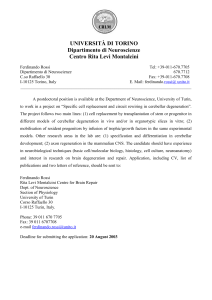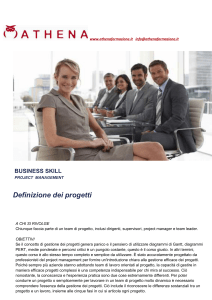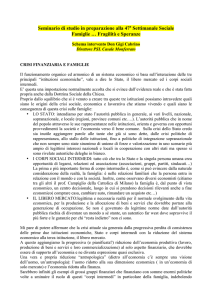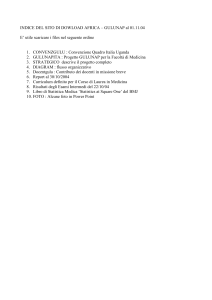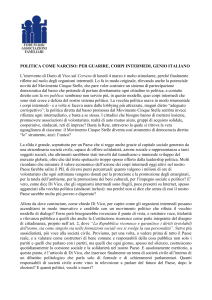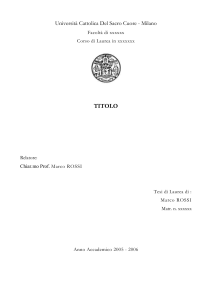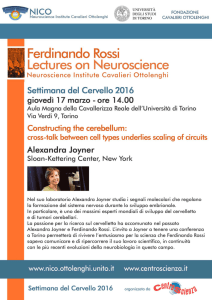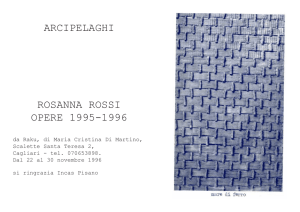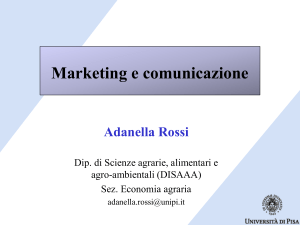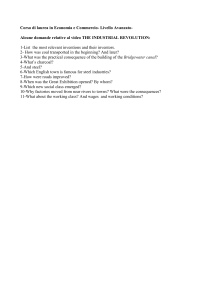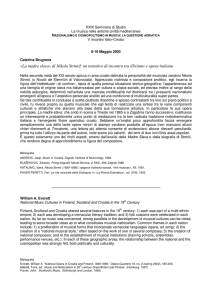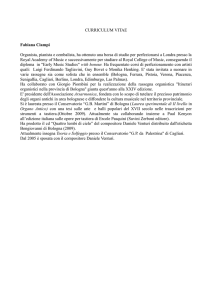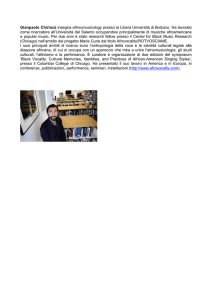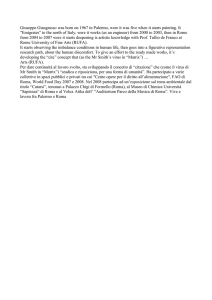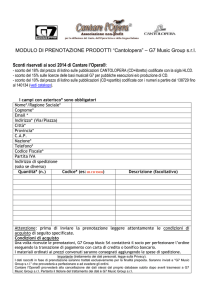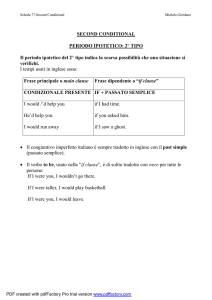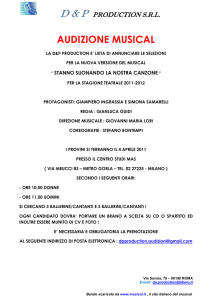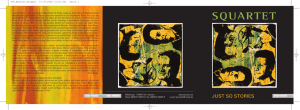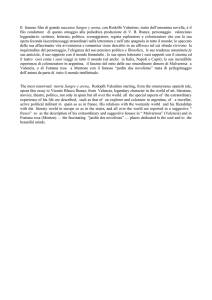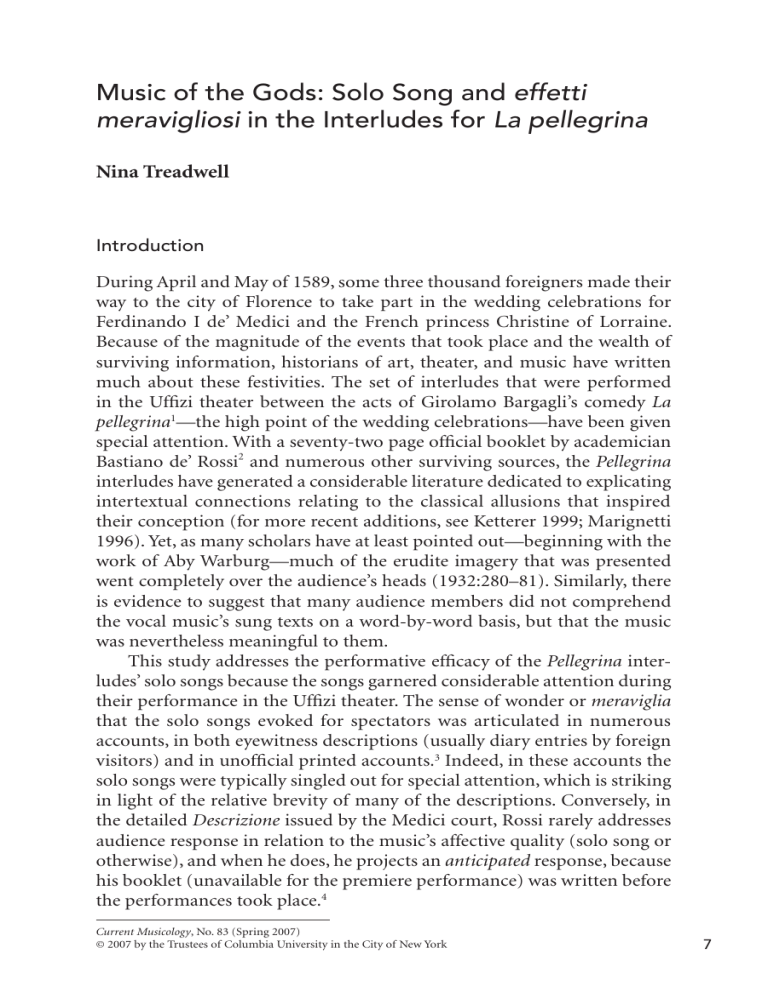
Music of the Gods: Solo Song and effetti meravigliosi in the Interludes for La pellegrina Nina Treadwell Introduction During April and May of 1589, some three thousand foreigners made their way to the city of Florence to take part in the wedding celebrations for Ferdinando I de’ Medici and the French princess Christine of Lorraine. Because of the magnitude of the events that took place and the wealth of surviving information, historians of art, theater, and music have written much about these festivities. The set of interludes that were performed in the Uffizi theater between the acts of Girolamo Bargagli’s comedy La pellegrina1—the high point of the wedding celebrations—have been given special attention. With a seventy-two page official booklet by academician Bastiano de’ Rossi2 and numerous other surviving sources, the Pellegrina interludes have generated a considerable literature dedicated to explicating intertextual connections relating to the classical allusions that inspired their conception (for more recent additions, see Ketterer 1999; Marignetti 1996). Yet, as many scholars have at least pointed out—beginning with the work of Aby Warburg—much of the erudite imagery that was presented went completely over the audience’s heads (1932:280–81). Similarly, there is evidence to suggest that many audience members did not comprehend the vocal music’s sung texts on a word-by-word basis, but that the music was nevertheless meaningful to them. This study addresses the performative efficacy of the Pellegrina interludes’ solo songs because the songs garnered considerable attention during their performance in the Uffizi theater. The sense of wonder or meraviglia that the solo songs evoked for spectators was articulated in numerous accounts, in both eyewitness descriptions (usually diary entries by foreign visitors) and in unofficial printed accounts.3 Indeed, in these accounts the solo songs were typically singled out for special attention, which is striking in light of the relative brevity of many of the descriptions. Conversely, in the detailed Descrizione issued by the Medici court, Rossi rarely addresses audience response in relation to the music’s affective quality (solo song or otherwise), and when he does, he projects an anticipated response, because his booklet (unavailable for the premiere performance) was written before the performances took place.4 Current Musicology, No. 83 (Spring 2007) © 2007 by the Trustees of Columbia University in the City of New York Current Musicology Most interpreters of the Pellegrina intermedi have disregarded the various unofficial narratives, probably because they do not agree in precise detail with Rossi’s account. Thus, unofficial sources have been neglected as a means of providing insight into the aesthetically and viscerally charged sensation of hearing (and seeing) the solo songs performed in the Uffizi theater. In conjunction with Rossi’s narrative, as well as with the Medici-sanctioned musical publication (Malvezzi 1591), unofficial sources help to demonstrate that the spectator-auditor’s perception of musical meraviglia was an essential component of the experiential dimension of the songs. Indeed, various wondrous effects produced by the solo songs—mystery, awe, confusion, and surprise (to name just a few)—impressed spectators with a princely mystique of ineffable authority. While details often differ among various sources, the experiences notated in unofficial accounts concur, in general terms, with theories of political control and kingship, and with Neoplatonic notions of musical magic—ideas that are explored in Part II of this study. In Part I, I demonstrate the various ways in which solo song was utilized for meraviglia-inspiring effect in the interludes. First, however, it is necessary to set the stage by examining the broader fascination with effetti meravigliosi or wondrous effects in the context of two opposing literary paradigms. Part I. The Experience of Wonder and the “Mystery of State” The aesthetic of wonder that was central to the Pellegrina intermedi was readily articulated in contemporaneous literary and artistic cultures as well as in the natural sciences and philosophy. In Renaissance poetics, wonder was the rhetorical figure that triggered surprise and epistemological confusion (Platt 1992:387). To oversimplify what was hardly a monolithic concept: wonder invoked a sense of the incomprehensible that in turn generated curiosity or desire for knowledge. Drawing on the work of Marvin T. Herrick (1947), Peter Platt has shown that Renaissance writers such as Francesco Robortello, Antonio Minturno, and Jacopo Mazzoni adopted a broadly Aristotelian conception of wonder whereby confusion (or incomprehensibility) was subject to rational scrutiny and thereby ultimately dissipated. In his Della difesa della comedia di Dante, for example, Mazzoni outlined thirty-four ways in which meraviglia could be transformed into verisimilitude (Hathaway 1968:77). Yet, from the vantage point of the spectator-auditor who witnessed the Pellegrina interludes, little enlightenment or edification of the Aristotelian sort appears to have taken place; in other words, understanding, reasoning, and knowledge among audience members remained partial. Descriptions Nina Treadwell by foreign visitors leave no doubt that, at times, the perceiver was at a loss to describe through rational explanation that which was observed and/or heard.5 Invoking what would become a familiar trope, the German diarist Barthold von Gadenstedt, who attended the premiere performance of the intermedi on May 2, wrote: “The splendor and great art of these intermedi cannot adequately be described, and those who have not seen this superhuman performed work cannot imagine how it could be possible” (Kümmel 1970:19).6 More specifically, Gadenstedt referred to the fourth intermedio in which a sorceress in her chariot traversed the heavens followed by a large cloud full of musicians: “These two pieces were very skillfully done, so that no one could recognize how it would ever be possible that something like this could be staged, or [how] something like this could have taken place so publicly in the open air” (Kümmel 1970:14).7 As I will show, the remarks by Gadenstedt are typical of responses found in unofficial accounts of the performances. In practice, therefore, it appears that the Aristotelian notion of wonder, with its emphasis on consequent demystification, was not at all pervasive (Platt 1997:2). Yet with one exception, in theoretical literature there were few challenges to the Aristotelian model of wonder. One of the most vehement challenges to Aristotle’s system came from the (then) Ferrara-based Neoplatonist Francesco Patrizi, whose work coincides with the years leading up to the preparations and performances of the Pellegrina intermedi. Patrizi rejected Aristotle’s concept of mimesis as the central principle of aesthetic judgment, replacing it with his own conception of meraviglia, to which he believed all poetry should aspire.8 He completed his book on wonder, La deca ammirabile, in 1587, a work that had been preceded in 1586 by La deca disputata, his most sustained attacked on the notion of Aristotelian imitation. Both volumes were part of his mammoth treatise on poetics, Della poetica (1969). Many of Patrizi’s ideas were likely well known to those involved in creating the Pellegrina intermedi, particularly to the poet G. B. Strozzi and Giovanni de’ Bardi who created the interludes’ invenzioni (plots). The friendship between Patrizi and Bardi extended back at least to the early 1580s.9 The two men were united in their effort to defend Lodovico Ariosto’s epic poem Orlando furioso against the attacks of Camillo Pellegrino.10 Bardi invited Patrizi to write Parere in difesa dell’Ariosto, which he subsequently dedicated to Bardi (Weinberg 1961, 2:1139). Bardi himself delivered a lecture on February 24, 1583, before the Florentine Accademia degli Alterati defending Orlando furioso from the criticisms of Pellegrino that centered on Ariosto’s abandonment of Aristotelian unity in favor of varietà (variety) (Weinberg 2:1116; Patrizi 1975:87n3). Bardi visited Patrizi on his trip to Ferrara and Current Musicology Mantua during 1584 and on June 12 of that year reported the chapter titles and parts therein of Patrizi’s Della poetica to the Accademia degli Alterati, which were then heatedly debated by the Aristotelian contingent, led by Lorenzo Giacomini (Hanning 1980:18; Palisca 1994:418). Further, there are notable passages in Rossi’s Descrizione of the Pellegrina interludes and Bardi’s Discorso that appear to be derived from Patrizi’s work.11 In his book Art and Power, Roy Strong groups Patrizi with other Utopian visionaries who understood the state as one element of a magical cosmology, and suggests that the intellectual framework constructed by such occult philosophers provided “a thought-context into which late Renaissance festivals would seem to naturally fit, both in the sense of the ideas they purvey and in their cultivation of mystical monarchy” (Strong 1984:73). Although Strong does not go on to develop a connection between Patrizi and aspects of Medicean state- or stagecraft, it is evident that Patrizi’s ideas provide a specific thought-context for the aesthetic and political aims of the Pellegrina intermedi. I have already noted that Patrizi and his works were well known to Bardi, who had a significant role in defining the conceptual framework for the intermedi. Further, in Patrizi’s conception of wonder, the reluctance to privilege the intellect resonated with a broader humanist worldview that tempered deference to classical authority with insights gleaned from practical experience. This “new cultural relativism,” as Gary Tomlinson has described it (1987:8), is particularly relevant to an understanding of the projection and experience of wonder that took place within the performance context of the Uffizi theater. Patrizi envisioned wonder as a special faculty of the mind that mediated between thought and feeling, that did not demand and, indeed, actively resisted ultimate resolution through rational explanation (Patrizi 1969, 2:361–62). A passage from Patrizi’s La deca ammirabile mirrors the spectator’s experience as frequently imagined by Rossi in his Descrizione and as described in unofficial accounts: Therefore something new and sudden and unexpected that appears in front of us, makes a movement in our soul, almost contradictory in itself of believing and not believing. Of believing because one sees that the thing exists; and of not believing because it is unexpected, and new, and not before by us either known, or thought, or believed to be possible. (Patrizi 1969, 2:365)12 Multimedia spectacle was the art form par excellence for producing unexpected or surprising effects, of course. Here Patrizi introduces the seemingly contradictory notion of “believing and not believing,” that is, the wondrous state that thrived on an absence of complete epistemological certainty. 10 Nina Treadwell Longinus was a chief influence on Patrizi’s views on wonder. As Platt has noted, both Longinus and Patrizi “advocated a poetical form of fragmentary, scattered bursts that, on account of their wonder-full and incredible nature, had the power to take the audience ‘out of themselves’” (Platt 1992:393). Similarly, the modus operandi of the intermedi—with emphasis on variety over unity—corresponded, on a larger scale, to the “fragmentary, scattered bursts” of Patrizian-Longinian (rather than Aristotelian) poetics. The Pellegrina intermedi seem designed to discombobulate, to transport the audience “out of themselves.” As such, they depended for their efficacy on a degree of mystification that paralleled the emergent trend toward mystical monarchy. Comments by Giuliano Giraldi regarding the apparent inconceivability of these Florentine spectacles over which Duke Ferdinando presided, confirm this intent: The superb decorations [apparato], the sumptuous show, the artful invention of priceless machines, the wondrous spectacles, which not only surpassed the expectations of all men everywhere, but also the imagination of the most expert and wisest men; not only were they [the spectacles] impossible to envision in our minds before they were performed, but once performed, and seen again, they could not be grasped by our minds. (Giraldi 1609:23)13 Gadenstedt concluded his description of the Pellegrina intermedi by lamenting his unsatisfied curiosity in regard to (one presumes) the interlude’s visual technologies: “We would appreciate the opportunity to see how this [the spectacle] could have been produced, but it was strictly forbidden to grant anybody permission to see this” (Kümmel 1970:19).14 As spectator-diarist, rather than Medici representative (c.f. Giraldi), Gadenstedt’s final remarks provide one explanation of why the Pellegrina interludes “could not be [completely] grasped” by those who witnessed them. Gadenstedt’s comments also remind us of what is now commonplace in studies of musico-theatrical court entertainment: the assumption that rituals of production and consumption were integrally tied to the political interests of those whose sponsorship produced them. As such, the wonder that was evoked in the Uffizi theater in 1589 served the interests of nascent absolutism, and was one part of a more general campaign by the newly installed Duke Ferdinando to posit himself as god-like, and the performance he offered as a “mystery of state.”15 Despite the encyclopedic scope of Rossi’s official account of the production, I argue that the performances themselves remained purposefully elusive; the very nature of the genre guaranteed that they could not be fully apprehended by attendees, as Giraldi affirmed. As a result, the production—which included music as a politically charged component—mapped out a division between the all-knowing, god-like duke (who seemingly enabled the production of 11 Current Musicology wonder) and the various audience members who participated in the quest for understanding that, according to the rules of the “theatrical game,” could only be realized to a limited degree.16 For the Florentine courtier, the ineffable elements of the court intermedi were reflected in the courtier’s daily enactment of sprezzatura, that elusive essence of courtliness that defied any exacting verbal description. As Mario Biagioli points out, “Both the opacity of sprezzatura and the ‘mystery’ of the source of the prince’s power were aimed at shielding his power from being discursively probed” (1993:52). For all its efficacy, then, the prince’s absolute power—whether exercised through the art of musical theater or undergirded by an elaborate spy network—must perforce remain “a mystery of state.” Little wonder, then, that Gadenstedt was denied access to the mechanisms through which the intermedi worked their wonders. Solo Song and the Marvelous I turn now to the solo songs that were singled out by eyewitnesses and other unofficial commentators. The strategic positioning of several of the songs—three functioned as opening numbers for interludes one, four, and five—give them special structural importance.17 The solo songs also provide a key point of entry for understanding the historiographical issues involved in writing about the process-oriented experience of listening to (and seeing) music performed in a theatrical context on the eve of the “birth of opera.” While the inclusion of a number of solo songs in the Pellegrina interludes has ensured an almost obligatory reference to them in cursory histories of opera, the songs have not fared particularly well under more focused musicological scrutiny. One of the central issues concerns the prevalent use of passagework or diminution in the songs; Tim Carter identified this problem when he wrote that the virtuosic passagework in Jacopo Peri’s “Dunque fra torbide onde” (from interlude five) “would hardly have found approval in the Camerata” (1989:117–18). The fact that in many respects the solo songs do not meet the aesthetic ideals of Giovanni de’ Bardi’s Camerata, nor of the birth-of-opera narrative, seems to have influenced recent critical assessment. Several of the songs have been assessed in terms that imply they possess a lack of fluidity. Carter refers to the awkwardness and lack of suavity in “Dunque fra torbide onde” (1989:118–21) and Warren Kirkendale criticizes Emilio de’ Cavalieri’s “Godi, turba mortal” sung by the castrato Onofrio Gualfreducci in intermedio six because of its “frigid[ity]” (2001:166), apparently finding the piece devoid of feeling. Evidently, these songs do not always provide the modern-day listener with a satisfying forward-moving trajectory by comparison, one assumes, with early opera 12 Nina Treadwell or chamber monody. In other words, the songs have defied a desire by the listener to perceive a succession of necessary and related moments in a musical whole. Ironically, assessments such as those of Kirkendale and Carter touch on one element that may have made these pieces especially successful in their original theatrical performance context. In Peri’s song, for example, disjunctions between phrases and seemingly unwieldy, but wide-ranging, passagework within phrases may have contributed to a wondrous effect, one that emphasized fractured musical moments and an impression of musical stasis as opposed to gathering momentum. Kirkendale’s assessment of the Pellegrina solo songs is worth citing at length because he draws together the issues of “excessive” passagework and text audibility: The elaborate, inexpressive embellishment of vocal solos, as taught in the diminution manuals of the sixteenth century, was a practice favored more by singers than by composers. Its extreme application might have some justification as an exercise in vocal pedagogy, but in musical compositions such as those of 1589 the results are questionable, becoming almost caricatures in their excessive artificiality. The unrelieved long melismas, often on insignificant words and thus not motivated by meaning, render the text unintelligible (anticipating Bellini or Donizetti). (Kirkendale 2001:166) Kirkendale raises a number of issues here, but I will focus on the question of text intelligibility, or lack thereof. Indeed, it is true that many spectators were at a loss to fully understand the words of the sung music. This matter seems to have been of some concern to those who created the intermedi. Some three years earlier, Rossi had addressed the issue in his Descrizione for Bardi’s play L’amico fido (for which Bardi had composed music for the sixth intermedio). Rossi stated that Bardi immediately turned to the musical part, in which he principally wished that the pomp and the finesse of his poem should resplend, so that he wanted that harmony to come out, most copiously, most full, most varied, most sweet, and most artful, above every other [harmony], and at the same time (which is something that is thought to be almost impossible) that it [the music] would be most clear and the words easy to understand, and the connoisseurs will also be able to judge this for themselves through the publication. (Rossi 1585:2r.)18 Curiously, the concern with textual clarity emphasized in Rossi’s 1585 Descrizione is entirely absent from the equivalent passage in 1589. In the account above it is not entirely clear why Rossi suggested that it was “thought to be almost impossible” for “the words [to be] easy to understand.” Perhaps he was implying that pragmatic concerns regarding the performance would 13 Current Musicology pose obstacles in this respect: the difficulty of producing music in the large and cavernous Uffizi theater (as opposed to more intimate settings, such as the rooms of Bardi’s palazzo) and the frequent use of instruments to double voices and/or provide elaborate continuo accompaniment would be obvious factors, aside from the extensive employment of passaggi (passagework) in solo songs. Because of this concern for textual clarity, Rossi specified that the music in notated form would be sufficient proof of composers’ intent that the words be easily understood, and in doing so tried to pre-empt any complaints on this point. Indeed, a brief report regarding the Pellegrina intermedi sent by Michele Priuli to Cardinal Montalto in Rome (dated May 6) voiced this very complaint: there were “very beautiful and weighty concerti, and so many musicians and instruments that one did not even understand the words of the music” (cited in Kirkendale 2001:174n59).19 It is also clear from the numerous misidentifications of characters and contexts in a number of unofficial accounts that in many instances the audience not only missed visual cues but also confused textual ones, even as the gods sometimes identified themselves during the course of their solo song or were identified by other characters. Evidently, many in the audience could not either hear the sung words or understand them. Despite the unintelligible words, the solo songs were nevertheless effective in performance and this fact poses a direct challenge to one of the key precepts on which musicologists’ understanding of this pivotal historical moment has been based: the conception that the efficacy of late Renaissance Italian music lay in the expression (and assumed intelligibility) of a verbal text. What is problematic is that this perspective was propounded in the official music-theoretical writings of musicians such as Bardi and Cavalieri who, as a result of their connection to the Florentine court, were intimately involved with the Pellegrina production (Cavalieri 1600; Caccini 1601; for Bardi see Palisca 1989:90–131). Thus, key documents that have continued to inform our understanding of the musical aesthetic of this “transitional” period have been used, unconsciously or not, as the critical lens through which to assess the solo songs, when the testament of unofficial accounts, the practical realities of the performance conditions, and close readings of Rossi’s Descrizioni suggest that the music’s efficacy did not rely, in fact, on comprehension of the songs’ texts. Regarding the latter, Rossi—as mouthpiece for Bardi—indirectly indicates as much by way of his reference (cited above) to the “almost impossible” task of making the words clear and “easy to understand.”20 Text clarity is not dismissed, however, but deflected to the printed (not performative) medium, which could be assessed by connoisseurs outside of the performance context. My interest here, however, is to identify those devices associated with meraviglia that ensured an efficacious 14 Nina Treadwell Figure 1: Cristofano Malvezzi, “Io che l’onde raffreno” (from intermedio five). Intermedii et concerti, canto partbook, 27. (Bildarchiv der Österreichischen Nationalbibliothek, Vienna, S.A.78.B.48, by permission.) 15 Current Musicology outcome during the 1589 performances. Specifically, I will discuss the use of florid passagework (the appropriate symbolic language for the gods), the use of echo effects, the projection of musical stasis (i.e., the control of time), surprise effects, “invisible” music, and music’s capacity to delineate space as a means of projecting a sense of the incomprehensible. I begin with one of the most problematic solo songs because the music, as it survives in notation (figure 1), is only a skeleton of what was apparently sung in performance. “Io che l’onde raffreno” opened the fifth intermedio in which Anfitrite, the Queen of the Sea, emerged from her watery kingdom to salute Duke Ferdinando and his bride (Malvezzi 1591, nono:11): Io che l’onde raffreno A mio talento, e son del mar Regina, A cui s’attera, e’inchina Ad inchinarmi, ò Regi Sposi vegno, Fin dal profondo del mio vasto regno. Ogni nume, ch’al mar alberga in seno I, who still the waves According to my will, and am Queen of the Sea, Before whom bows down in reverence Every divinity who dwells in the bosom of the sea: To bow down to you, O royal pair, I come From the depths of my vast realm. Although the song only survives in Cristofano Malvezzi’s syllabic five-part version in the official musical publication, the composer himself tells us that Vittoria Archilei, the Florentine court’s prima donna, sang the piece as a solo “maravigliosamente” (1591, nono:11), likely implying that she embellished the canto part with at least some passagework. Although we cannot be certain of the exact nature and extent of the passagework that Archilei might have incorporated into her performance, one commentator, Simone Cavallino, gives us some idea of the general mood that the singer conveyed. Like several other writers, Cavallino mistakes Anfitrite for a siren, but pays particular attention to the perceived effect that the song exerted on audience members: In the blink of an eye [the scene] became a tempestuous sea [with] hard rocks and waves that appeared so natural, that everyone was amazed by looking at them, because they made that foam that one is accustomed to [see] with the real sea. In the middle of the above-mentioned waves appeared a very beautiful siren—with nine of her prisoners—with such a sweet singing that it would not have been anything to wonder about if it had put to sleep and softened every hard heart; then after singing for a good amount of time, she disappeared. (Cavallino 1589:5)21 16 Nina Treadwell Cavallino’s use of the verb stupefare indicates that before the singer even appeared, the audience was astonished by the visual scene or was “past all sense,” to use John Florio’s translation (1611:542). In essence, the audience was, in the Patrizian sense, in a wondrous state of “believing and not believing,” believing because the scene existed, but not believing because of the scene’s sudden appearance and its striking resemblance to reality. (While Cavallino stresses verisimilitude, it is the unbelievable, seemingly impossible nature of the feat that evokes meraviglia.) In the singing that followed, Cavallino paid particular attention to the perceived effect that the solo song exerted on audience members. For Cavallino, the siren’s song had the power to move the audience by softening their hearts, and lulling them to sleep as the legendary sirens had done to the sailors of antiquity. Indeed, in Cavallino’s mind the song had already exerted its intended effect, because the singer was accompanied by “nine of her prisoners,” whose hearts she had already “captured.” Female singers were frequently likened to sirens during this period, but there was often confusion surrounding the nature of their power—did it lead men from earthly desire to ultimate destruction, or to a higher spiritual plane? That Cavallino and others mistook Anfitrite for a siren testifies to the prevalence of the siren’s figure in the popular imagination, but it also indicates the power that the siren’s (Archilei’s) song was perceived to exert over listeners. Yet Cavallino’s account does not suggest that listeners were overwhelmed by the kind of flashy passagework that characterized other solos in the intermedi, in which the complexity of the passaggi generally increased as the song progressed; rather, Archilei’s singing seems to have had a more subtle, yet no less powerful effect. Writing in a figurative, not literal sense, Cavallino tries to convey the intensity of the experience of the performance by alluding to a dream-like state. If we follow Cavallino’s impressions (which are, indeed, the most detailed that we have), the sleep-inducing quality of the song must have called for a completely different approach that relied only partly on the singer’s ability to articulate intricate passagework, but mostly depended on the singer’s ingegno—an imaginative capacity to invent or fashion the new. In fact, Archilei was renowned for her ingegno, an ability that was mentioned by several of her contemporaries, including her Pellegrina colleague, Jacopo Peri. In Peri’s words, Archilei was the singer who has always made my music worthy of her singing, but adorns it not only with those gruppi and those long windings of the voice, [both] simple and double, that her vivezza dell’ingegno [liveliness of invention] can devise at any time—more to obey the usage of our time than because she regards the beauty and force of our singing to rely upon them—but also of those pleasantries and beauties that one is not able to write, and if written, can not be learnt from the written [examples]. (Peri 1601:iii–iv)22 17 Current Musicology It is striking that Peri used the term ingegno to describe Archilei’s imaginative acumen. Ingegno was understood as a masculine attribute that suggested imagination, inventiveness, and initiative (Florio 1611:253); in literary circles it was regarded as a poetic faculty par excellence and was also highly prized in the visual arts. Peri’s reference to the singer’s “vivezza dell’ingegno” is mentioned in the context of her capacity to invent various kinds of ornamentation at will, but what is even more interesting for our purposes is the continuation of Peri’s description as he notes the current vogue for passaggi. To be sure, as a Florentine court musician, Archilei’s livelihood depended on her ability to execute such passagework with brilliance and precision, as she did in the very opening of the set of intermedi. Yet Peri suggested that Archilei herself did not believe that “the beauty and power” of singing solely relied upon them. Indeed, the “pleasantries and beauties” that Peri went on to mention would not necessarily have referred to ornamentation, as has sometimes been assumed.23 It is more likely that he meant other expressive devices for which singers from these circles were renowned and which, as Peri pointed out, could “not be learnt from the written [examples].” Comments by Vincenzo Giustiniani describing the singing of the ladies from the closely related courts of Mantua and Ferrara will serve to outline some of the expressive effects to which Peri may have been referring. Giustiniani mentions the use of well-placed passaggi, but continues by outlining more subtle effects: Moreover, by moderating or increasing the voice, loud or soft, making it light or heavy, according to the sections [of a particular song], now drawing it out, now dividing it with the accompaniment of a sweet interrupted sigh, now stretching passages out, well followed, detached, now gruppi, now leaps, now long trilli, now brief [trilli], and now with sweet passaggi sung softly . . . and with many other particular artifices and observations that will be of note to people more experienced than myself. (Solerti 1903:108)24 Omitted from the excerpt above are references to appropriate physical demeanor, particularly with regard to the body (trunk), hands, and parts of the face. It is difficult to know to what extent Vittoria might have employed these more subtle physical gestures in her performance of “Io che l’onde raffreno” in the large Uffizi theater; initially, she had to negotiate the rising movement of her machine with lute in hand (Rossi 1589:56; Anon. 1589a). The mother-of-pearl shell on which she was perched was intentionally tossed about by the waves (Rossi 1589:55; Pavoni 1589:20) but presumably the waves subsided as she sang her opening line “Io che l’onde raffreno.” It seems clear, however, that the subtleties of Archilei’s expressive arsenal must have accounted, in part, for the song’s efficacy in performance. Indeed, the 18 Nina Treadwell song did not require a pronounced teleology in order to evoke a sense of wonder in the auditor. The fourth intermedio, like the fifth, began with a solo song, but in intermedio four the singer was intended to represent a sorceress whose song attempted to invoke the fire demons. The sorceress in her chariot unexpectedly intruded upon the scene from the previous act of the comedy, a gesture observed by a number of spectators (Monga 1994:114; Anon. 1589a). The nature of her unexpected appearance was no doubt prompted by the popular conception of the sorceress (or witch) as a figure of disruption and disorder, but what also garnered attention was the fact that spectators were unable to figure out exactly how the chariot flew through the air to the center of the stage, while remaining close to the Heavens. One anonymous Italian commentator notes: “Without changing the sets, a sorceress’s chariot appears in the air, pulled by two dragons, a wondrous thing because one was not able to see by what means it moved” (Anon. 1589a; see also Katritzky 2001:233, 237; Monga 1994:114; Kümmel 1970:14).25 Likewise, Rossi’s Descrizione stresses the visual components of the scene—with particular emphasis on the sorceress’s disheveled appearance—but does not go to any lengths to describe the affective quality of the music that she sang. It is striking, however, that Cavallino’s comparatively brief account again emphasizes the musical dimension. He states: “The fourth intermedio gave no less amazement to the eye than wonder to the ear” (1589:5),26 suggesting that the visual and aural components of the scene were on equal footing in their capacity to evoke the wondrous. Regarding the sorceress’s song in particular, Cavallino notes: “There was a woman who sang alone, and in such a manner that all ears were attentive [in order] to listen to her” (1589:5).27 The song to which Cavallino referred was composed by Giulio Caccini and sung by his first wife, Lucia Caccini: Io che dal ciel cader farei la luna A voi, ch’in alto sete, E tutt’il ciel vedet’e voi commando Ditene quando il sommo eterno giove Dal ciel in terra ogni sua gratia piove. I, who could make the moon fall from the heavens, To you who are on high And see all of heaven, I command you: Tell us when the almighty, eternal Jove Will pour down his every grace from the heavens to the earth.28 As the utterance of a sorceress, both the singer’s delivery and the music her husband notated seems to have been designed to suggest the sorceress’s 19 Current Musicology Example 1: Giulio Caccini, “Io che dal ciel cader farei la luna” (from intermedio four). Transcribed from both Florence, Biblioteca Nazionale Centrale, Magl. XIX.66 and Brussells, Conservatoire Royal de Musique, ms. 704. 20 Nina Treadwell (Example 1 continued) 21 Current Musicology spellbinding powers. Producing the latter may have been a difficult task for a composer such as Giulio Caccini, whose own reluctance to employ a consistently florid vocal style—a sure-fire technique for evoking the marvelous—is well known. In many ways, Caccini’s compositional strategy is typical of his style, with passaggi almost invariably falling on the penultimate syllable of a phrase (see example 1). This formula was one he put into practice and advocated in print, railing against those singers whose words could not be understood because of excessive embellishment (Caccini 1970:43–47). The impression of invocation would have been produced by the declamatory fashion in which Lucia Caccini, as sorceress, first summoned the demons, hence the speech-like setting and repetition (with slight embellishment) on the words “Io” (I) and “a voi” (to you) (see example 1, mm. 1–2 and mm. 5–6). The text repetitions here emphasize the sorceress’s attempt to contact her demonic cohorts; to the less savvy auditor-spectator, the emphasis on “I” and “you” in the text would have at least conveyed the intensity of the the singer’s relationship with certain unknown, but potentially powerful, deities. In general, the setting conforms with Giulio Caccini’s views on correct text setting. However, the use of passagework is extensive, and does not always appear to be prompted by the meaning of individual words. For the listener, the wondrous experience was likely evinced through the mounting complexity of the passagework in the first half of the poem, with each successive phrase outdoing the last, culminating on “commando” (mm. 10–13). This strategy included the use of passaggi on syllables of words that did not call for any special treatment: see, for example, the passaggi on “sete” (mm. 7–8) and later in the song, on “quando” (mm. 15–16). The dramatic timing of Lucia’s silences between phrases would have likely created a sense of expectation in the listener and along with a commanding delivery might explain Cavallino’s emphasis on the audience’s attentive ears. On two occasions—at m. 14 and m. 18—the continuo is silent in conjunction with the voice. These dramatic pauses would have given the sorceress’s assumed listeners a moment to absorb both her spellbinding virtuosity and the implications of her demands. In this sense, too, Lucia’s song could make a powerful impression, without the auditor necessarily attaining word-for-word comprehension. Finally, it is the suggestion of Jove’s power to pour down his grace that prompts her concluding flourish, with the dotted-rhythm figure “painting” the word “piove” (mm. 20–22).29 In key moments in the song the intricacy of the passagework likely became the central object of the auditor’s attention to the exclusion of all else. There is an aesthetic parallel here between Caccini’s song as it may have been experienced in performance and Rossi’s explanation of the visual aes22 Nina Treadwell thetic that dominated the intermedi at the meta-level. Various comments by Rossi in his Descrizione (supported by the testimony in unofficial accounts) suggest that part of the experience of meraviglia involved the trumping of one wonder by the next—to the extent that it was possible to forget almost immediately what one had witnessed only moments before (Rossi 1589:19). Similarly, lighting could be designed so that it became difficult for the eye to rest on certain visual components of the scene (Rossi 1589:23). The point appears to have been to keep the perceiver “off balance” and in a state of instability so that each intermedio and the performance as a whole were always just beyond the spectator’s grasp. Caccini’s solo song demonstrates how each phrase of passagework could outdo the last (by potentially nullifying the impression of the previous one), either through increased complexity over the course of the song or through a striking stylistic shift. Indeed, it was those singers versed in Neapolitan-style embellishment—a style of passagework particularly associated with southern Italian musicians—that were actively sought after by the Medici. It is thus no accident that several of the soloists chosen to perform in the 1589 intermedi, including Archilei and Gualfreducci, had Roman connections.30 The solos that include embellished versions in the official print are characterized by the kind of extensive passaggi that assumed the singer had dispositione di voce, a vocal disposition that made the singing of elaborate passagework possible (Greenlee 1987). According to the Roman singer Giovanni Luca Conforti, disposition was possessed by few singers (1593:1–1v); it was a means of articulating embellishments with the throat that, when successfully rendered, could result in clear, precise, and rapid articulation. Good disposition allowed the execution of seemingly impossible embellishment, often involving leaps and repeated notes in unrelenting scalar passages sung at lightning speed. In and of itself the experience of hearing a singer endowed with this ability seems to have been cause for certain wonderment. Bardi admitted as much upon hearing an extraordinary bass singer in Rome, despite criticizing the practice in his Discorso (Palisca 1989:122).31 Transfixed by the rapid glottal articulations employed to execute intricate passaggi, at times the auditor may have lost a firm grasp of the relationship between the momentary experience and the structure of the musical whole. In poetic terms, the aesthetic corresponds to the “fragmentary, scattered bursts” of Patrizian-Longinian poetics. A thoroughgoing example that emphasized the wondrousness of momentary experience in quite a different way was the song assigned to the legendary Greek poet-musician Arion in intermedio five. Along with florid passagework, a double echo was introduced that became the governing principle structuring the piece. Arion’s song was composed and sung by 23 Current Musicology the virtuoso Jacopo Peri, who also accompanied himself on the chitarrone. Although the poet is unknown, the poem appears in Malvezzi’s print (1591 nono:12): Dunque fra torbide onde Gli ultimi miei sospir mandero fore, Ecco gentil con tuoi suavi accenti: Raddoppia i miei tormenti; Hai, lacrime, ahi dolore, Hai morte troppo acerba e troppo dura. Thus among the murky waves I will breathe my final sighs. Ma deh chi n’assicura: O di Terra o di Cielo S’a torto io mi querelo: E s’a ragion mi doglio; Movetevi a pietà del mio cordoglio. But who can assure me, On earth or in the heavens, If I am wrong to complain? And if my foreboding is justified Have pity on me in my plight. Gentle echo, with your sweet accents Reiterate my torments Alas tears! Alas pain! Alas, death, too bitter and too hard! The power of Arion’s plaintive, yet meraviglia-inspiring song ultimately saved the poet-musician from his mutinous crew. After Arion jumped overboard to escape them, a dolphin carried him safely to shore, attracted by his sweet singing. Echoes responded to Arion at most of the line-end cadences, and were also summoned within poetic lines to emphasize dramatic exclamations on the word “hai” (alas) in the first stanza (see example 2, mm. 14–19) and “pietà” (pity) in the final line of the second stanza (see example 3, mm. 37–39). The wondrousness seems to have been produced, in part, by a projection of musical stasis or immobility as each line or short phrase was iterated twice before the singer could proceed. In this way, the echoes effectively delayed the perception of the passing of time; and like virtuosity, the device was self-referential, calling attention back to sound itself. The song did not provide the listener with a succession of related moments, but rather produced self-contained “snapshots” of wonder with attendant ripple effects produced by the double echoes. Unexpected chordal shifts also served to produce a sense of disjunction between phrases. See, for example, the third-related chord shift in example 2 (mm. 23–24), which emphasized Arion’s disbelief—with the word “ma” (but)—after contemplating a death that would be “too bitter and too hard.” In addition, Peri’s song drew on the so-called bastarda style in which the soloist not only performed florid passagework in his natural voice range—Peri was a tenor—but expanded the range of available pitches, both above and below, to incorporate elements of the bass and alto parts that are found in the surviving four-part score. Drawing on the alto voice was particularly appropriate toward the end 24 Nina Treadwell of the song when Arion’s sense of foreboding reaches a peak. In example 3 (mm. 33–35) the gradually ascending eighth notes on the text, “And if my foreboding is justified,” culminating on the high E (at m. 35) reflected Arion’s fearfulness and dread by moving into the singer’s lighter alto voice range to elaborate passaggi. The singer’s ability to traverse various parts of the ambitus exemplified the kind of Herculean feat that was expected of the virtuoso in this context, but may have contributed to recent scholarly criticism that describes Peri’s song as awkward and lacking suavity. The range explored by the singer is roughly two octaves, yet accomplished bass singers at this time were known to sing bastarda style with a range of up to three octaves. Indeed, as Richard Wistreich has demonstrated (2002), the bass singer Giulio Cesare Brancaccio, while criticized by connoisseurs for subverting the musical architecture of a piece, could astonish his audience by applying passagework across the entire range of a four-voice madrigal, making porous the boundaries between discrete parts of the musical texture. Similarly, in the 1589 performances, the addition of extensive and wide-ranging passagework in Peri’s solo song likely drew the listener toward an experience of momentary effects, one that actively worked against a perceived sense of the song’s larger design. I now turn to the opening number of the first intermedio to provide a more extended analysis demonstrating how perceptions of time and space were manipulated through the confluence of aural and visual media to produce a sense of wonder in the audience. The first intermedio began with an extended solo song sung by Vittoria Archilei, who was deployed on a cloud that emerged, very slowly, from the flyloft of the theater. Archilei personified Harmony of the Spheres (or more specifically, Dorian Harmony), but we know that few in the audience recognized the singer as such, either by her visual appearance or by the self-identifying pronouncement during the course of her song “Dalle più alte sfere”: Dalle più alte sfere Di celesti Sirene amica scorta, L’Armonia son, ch’à voi vengo, o mortali: Poscia che fino al Ciel battendo l’ali L’alta fama n’apporta, Che mai sì nobil coppia il Sol non vide, Qual voi nuova Minerva, e forte Alcide. 32 From the highest spheres, As friendly escort to the celestial Sirens, I, Harmony, come [down] to you, O mortals: Because, beating its wings, Exulted Fame has brought up to Heaven [the news] That never has the sun seen such a noble couple, As you, new Minerva and strong Hercules.32 25 Current Musicology Example 2: Jacopo Peri, “Dunque fra torbide onde,” mm. 14–24 (from intermedio five). Transcribed from Intermedii et concerti (Venice: Giacomo Vincenti, 1591). 26 Nina Treadwell (Example 2 continued) 27 Current Musicology Example 3: Jacopo Peri, “Dunque fra torbide onde,” mm. 33–43 (from intermedio five). Transcribed from Intermedii et concerti (Venice: Giacomo Vincenti, 1591). 28 Nina Treadwell (Example 3 continued) 29 Current Musicology Eyewitness accounts of the performances of this opening number suggest that Harmony’s song was meaningful, but that its efficacy was not dependent on word-for-word comprehension of the song’s text.33 The most frequent point of comment concerned the affective quality of the singer’s voice. The German eyewitness Gadenstedt notes, for example, that She [Harmony] began to sing so sweetly at the same time “beating” on the lute, so that everyone said that it was impossible that a human voice could be so sweet, [and] also so moved all the spectators with her singing that they just could not describe it. (Kummel 1970:7–8)34 It might be tempting to dismiss the remarks of Gadenstedt and others who emphasized the ineffable sweetness of the singer’s voice as poetic cliché or as part of a broader phenomenon that Lorenzo Bianconi has described as the “cult of ineffability”—of which it undoubtedly was (1987:61). It is important to remember, however, that Archilei was experienced in singing “alla napoletana,” enabling her to perform exceedingly florid embellishment with great speed. She could elaborate passagework in the upper reaches of the soprano range with ease, thus projecting an impression of superhuman virtuosity. In the broadest sense, then, the affective quality of Archilei’s song in performance was due to her extraordinary facility as an exponent of Neapolitan-style singing. The intricate, ever-changing passagework that we see on the printed page (see figure 2) was likely experienced in performance in terms of broad affective gestures that were delineated sectionally. Indeed, through such shifts, and because of increasingly demanding and spectacular passagework, the song has impressed modern commentators by exuding an overarching impression of gathering momentum. The florid passagework that characterizes what some have assumed to be the song’s final section—beginning with a second statement of the words “Qual voi”—is, to judge from recent recordings, the most technically demanding and aurally breathtaking of the piece. Yet I would argue that while, on the printed page, Archilei’s song appears to gather momentum as it proceeds, the song’s forward motion was counterbalanced in the 1589 performances by the visual perception of the singer on a slowly descending cloud.35 Rossi described the visual dimension of the scene thus: When the curtains fell one immediately saw a cloud appear in the sky, and on earth, at the front of the stage, a little Doric temple of rustic stone. A woman in the cloud, that came little by little to the earth, was playing a lute and singing . . . And while the above-mentioned cloud descended to earth little by little, and having under it some sunbeams, it seemed that by following them [the sunbeams], it gradually, as it moved, covered the sun. (Rossi 1589:18–19)36 30 Nina Treadwell Figure 2: Vittoria Archilei, “Dalle più alte sfere,” excerpt of passaggi for concluding sections (from intermedio one). Intermedii et concerti, canto partbook, 6. (Bildarchiv der Österreichischen Nationalbibliothek, Vienna, S.A.78.B.48, by permission.) 31 Current Musicology Almost all descriptions—eyewitness and otherwise—stress the barely perceptible nature of the descent, leaving spectators at a loss as to exactly how the cloud moved as it gradually descended from the Heavens (see especially Anon. 1589b; Kümmel 1970:7–8). This impression, to which the creators of the intermedi had given special attention,37 was part of the wonder and the theatrical game, of course, and resonated with the Patrizian concept of incomprehensibility. My point here, however, is to suggest that the combined effect of aural and visual media would have produced a sense of time suspended—of time standing still—rather than projecting an impression of gathering momentum. This impression would have been fortified by the necessarily limited physical motion of Archilei as she sang to her lute; indeed, the technique required for singing such elaborate passagework required the singer to remain as physically motionless as possible.38 The floating, translucent quality of Archilei’s passagework was reinforced by the flexible accompaniment of plucked-string instruments that included the singer’s own “leuto grosso” and two chitarroni played from behind the scenes. The newly “invented” chitarrone—with its extension neck facilitating a strong and extensive bass range—was able to create a variegated textural support for the singer’s extended “windings of the voice” in the upper range.39 The exclusion of a (sustaining) bowed bass instrument for accompaniment here was crucial because not only did the absence of such a sonority lessen treble/bass polarity, but it also helped to defuse the momentum of tonal directionality. Thus, the overarching purpose of this opening emblematic tableau—the singer’s mesmerizingly incremental descent—was to initiate the spectator into the magical world of the intermedi, providing a “psychic displacement from the ordinary”40 that would prepare the perceiver for the new and unexpected sonic and visual shifts that followed. That the spectator experienced the event on a quasi-religious or mystical level is suggested by the terms used to describe the sound quality of Archilei’s voice. The notion of incomprehensibility was commonly associated with the mysteries of the Christian faith, and the frequency with which words such as stupefare and meraviglia occur in written accounts suggests the dreamlike, otherworldly quality of the experience. Thus, while Archilei was not recognized as a personification of Harmony, her music and visual presentation produced the intended effect. The religious connotations wrought by Archilei’s performance are perhaps most clearly revealed by the perception of the singer as an angel or goddess (rather than as Dorian Harmony). Cavallino attributed this perception to both her visual appearance and her sonorous singing style (1589:3).41 The most obvious cue for many spectators was the singer’s iconic status as she descended from the Heavens, a perception that was intentionally 32 Nina Treadwell elicited by producer Emilio de’ Cavalieri at rehearsal when he ordered the enlargement of Archilei’s cloud so that it surrounded her from above (as well as below) to produce an almost halo-like effect.42 In this manner, the opening of the first intermedio mimicked the kind of spectacular scenic effects utilized for decades in larger Florentine churches for the performance of sacred representations.43 The mechanical devices installed as permanent fixtures in some churches enabled angels and other celestial beings to hover in mid-air or enact spectacular descents on important occasions. But in the artificially generated environment of the closed court theater, Archilei’s spatial descent was a powerful metaphor for Medici control: with their stage crew literally pulling the invisible strings of wonder, the Medici were able to actualize their god-like power. Harmony’s descent also had profound philosophical significance as suggested by Bardi’s song text and the emblematic quality of the visual imagery. Because emblems were considered talismanic, some may have understood the descent to indicate what was being brought about invisibly, according to Ficinian Neoplatonism, a tradition in which Florentine intermedi were steeped. Thus, Harmony’s descent functioned in performance as a kind of choreographed magic, whereby cosmic harmony was brought to earth. From a Neoplatonic perspective, the spectator’s awe-struck response was, in essence, proof of the performance’s magical efficacy. The Mysterious Source of Sound With these considerations in mind, I will now discuss the significance of the concluding section of Harmony’s song. It has long been assumed that the musical print included two possible endings for Archilei’s song, a florid and more extensive “first ending” and a shorter “second ending” with echo effects (see figure 2; the “second ending” begins with the decorated initial).44 I previously alluded to the so-called first ending that concluded with increasingly dynamic passagework on the text “strong Hercules.” The shorter “second ending,” which set the same text, was characterized by repeated melodic cells and reiterated syllables in the text, suggesting that the second of each musical cell was performed as an echo. In recent recordings of the song, the echo ending has either been omitted or the endings as they appear in the musical print have been reversed. Either solution allows what appears to be the more vocally spectacular ending to conclude the piece.45 But several accounts, including one from an eyewitness, confirm that the echo ending concluded the premiere performance in the Uffizi theater.46 A manuscript description by an anonymous Frenchman who attended the premiere outlines the details: 33 Current Musicology In front of the stage, which is very large and high, there were two cloths that covered the entire stage. When they wished to begin, all of a sudden the first, which was red, fell to the ground. The second [cloth], which was like sky blue, remained, right in the middle of which appeared a lady who was seated in a cloud holding a lute in her hand. [She] sang and little by little descended to the stage, where she immediately disappeared. She played and sang so well that everyone admired her, and at the end of her song there was heard an echo that responded to her, which seemed to be quite far away from the stage, a mile or more. (Monga 1994:113)47 The account of Giuseppe Pavoni confirms the description by the anonymous Frenchman: There were two cloths covering the front of the stage. The first one which went down was red; the perspective was then seen although it was still covered by another cloth that was blue, in the middle of which was a woman that was seated on a cloud, and with a lute began to play and sing a madrigal very sweetly. And thus playing and singing she came, being lowered down little by little, hiding herself among certain rocks, and finishing the madrigal among those rocks with an echo so wonderful that it seemed like its bouncing back was a mile away. (Pavoni 1589:15)48 Additionally, Pavoni’s account refers to the “certain rocks” into which Archilei and her cloud disappeared at the end of her descent, and from whence she concluded her madrigal.49 The final echo section was thus performed out of the audience’s sight, and Pavoni confirms its wondrous effect. I will comment here on the several disorienting (and thus meraviglia-inspiring) surprises that audience members likely experienced at this moment in the performance. Many in the audience probably assumed that Archilei’s song had concluded with her spectacular final flourishes and her disappearance into the certi scogli (certain rocks). The music that was sung out of eyesight began in a more sustained, lyrical style with a reference to “new Minerva”—Christine of Lorraine, the new duchess of Florence (see figure 2, at the decorated initial).50 The opening three notes would have naturally incorporated a gradual crescendo, as the musical line slowly ascended by step. In 1589, the audience was likely caught off guard by the singer’s gradually emerging disembodied voice. And, no sooner had Archilei concluded this short lyrical phrase, than she began a rapidly articulated ascending motive that was immediately echoed, according to spectators, from a distance. From what is known of the theater’s setup it seems likely that Archilei’s echo was rendered by a singer stationed at the very back of the hall (out of sight) in or behind the small balcony above the main entrance,51 a position that would explain the emphasis in both descriptions on the considerable distance from which the echo seemed to originate.52 For the auditor, the 34 Nina Treadwell challenge and pleasure of the experience inhered simultaneously in the initial confusion engendered by the echo and in the attempt to describe the auditory experience—if only to suggest that the echo appeared to emanate from “quite far away from the stage, a mile or so.” Notice that the auditor does not definitively locate the echo’s source. To do so would have destroyed the novelty of the auditory sensation; thus, for meraviglia to be efficacious, knowledge must remain partial. In this final echo section, the auditor may not have understood the broken syllables of the words “forte Alcide” (strong Hercules), which referred to Duke Ferdinando himself: each syllable was treated in melismatic fashion and then instantaneously echoed.53 But the text’s conceit was surely demonstrated in the performance space by the musical effect. The duke’s pseudonym “strong Hercules” resounded back and forth from the stage to the far reaches of the hall, with sound actively expanding the limits of the (onstage) theatrical space, and transcending the bounds of the singer’s body now hidden from the audience’s view. Thus, sense of space, so frequently associated with visual perception, was actively redefined by aural means. In other words, the auditor-spectator’s experience of meraviglia—so frequently attached to visual perception—was here produced through the absence of “the sight of sound.”54 The political implications of the effect are clear: through sound, “strong Hercules” commanded the far reaches of the theatrical space, projecting an idealized vision of Medicean expansion and control.55 Yet the source of sound and the means through which it was articulated remained purposefully elusive to those who might try to track its origins. In essence, pure sound, as an emblem of Medicean political power, was elevated to the level of a “mystery of state.” Part II. Shoring Up Dynastic Prerogative: The Prince as God It is a well-known fact of Medicean political history that during the transition from republic to duchy, the family pursued policies and modes of self-representation that emphasized precedent and continuity with their forebears as a means of justifying their dynastic prerogative (Strong 1984; Berner 1970; Van Veen 1984). This project—which manifested itself in Medici-commissioned art works, ephemeral feste, and written texts such as funeral orations, descrizioni, or even more blatantly propagandistic works such as G. B. Strozzi’s Della famiglia de’ Medici—began with Duke Cosimo I and continued through the reigns of his successors. This mode of self-representation during Duke Ferdinando’s wedding festivities in 1589 can be readily identified through the series of arches and street decorations constructed for 35 Current Musicology the entrance of Christine of Lorraine into the city of Florence.56 It is evident from eyewitness accounts that spectators were generally able to “read” the political program suggested by the arches.57 Furthermore, the nature of the outdoor arches and street decorations enabled the viewer to observe them at leisure, in a manner quite distinct from the act of viewing imagery in the performance context of a closed court theater, such as that of the Uffizi. In a similar vein, the act of reading Rossi’s commemorative Descrizione allowed the reader to contemplate the text at will, but it also allowed the author, through the medium of print, to create a cohesive chronological narrative in the opening pages of his booklet that masked gaps in Medicean ancestral continuity (1589:1–6). Indeed, the virtue of magnificence as it applied to Medici rulers in general becomes the linchpin that holds the opening of Rossi’s narrative together, allowing him to emphasize precedent as evidence of the inevitability of Medici rule.58 By way of contrast, the performative dimension of the Pellegrina interludes—as opposed to their description through the written word by Rossi—made them the ideal medium for articulating another emergent strand of Medicean self-representation that characterized the period of the 1580s and beyond. Specifically, the projection of a distanced, god-like prince found its most powerful articulation during the performances of the Pellegrina interludes. Let us begin by considering how the decorations in the performance venue helped to project this impression. What is striking is that the decorations—described at length by Rossi (1589:7–17)—did not lend themselves to easy interpretation without the aide of his text, which was not available for the premiere performance. Aside from a few obvious references to the bride and groom, it is notable that most commentators, including eyewitness ones, only described the very general effect of the room on the viewer, with little if any reference to precise details of iconography. In general, commentators stressed the use of color and light in the room, emphasizing its richness and magnificence.59 Evidently, the average viewer had some difficultly ascribing any precise meaning to much of the Uffizi theater’s decorative content. For example, a series of statues variously based on themes associated with comedy and poetry seems to have been impossible to decipher without the aid of Rossi’s commentary.60 One also wonders whether more obvious iconographical gestures—such as the coat of arms of Ferdinando and his bride attached to the sixteen chandeliers—would even have been clearly visible at such a height.61 Despite his detailed descriptions, various comments by Rossi suggest what is plainly evident in most other written accounts: that during the performance the sum total of these iconographical details was to project a more generalized, overarching impression regarding “the extraordinary greatness and magnificence of this wedding” 36 Nina Treadwell (1589:13), thus paralleling the awe-inspired response by spectator-auditors to the performances themselves.62 The prevalence of abstract generalizations points to a new strand of Medicean self-representation that historian Samuel Berner has tied to the late Cinquecento, and particularly to the reign of Ferdinando. By examining the rhetoric of ducal funeral orations, Berner identifies a gradual shift in tone from a conception of the prince as a palpable, recognizable human being to one that figures the prince as someone without world concerns and thereby elevated to the celestial realm. According to Berner, the funeral oration delivered by Bernardo Davanzati to the Accademia degli Alterati depicted Duke Cosimo I moving “through a real, historical Florence and not through the nebulous sublunary expanse to which the divine-right theorists of the end of the century will assign Duke Ferdinando” (1970:186). Berner argues that the “lack of verisimilitude as well as the references to the divine-right theory of kingship” that emerge in Lorenzo Giacomini’s 1587 funeral oration for Duke Francesco “find their full expression in the orations delivered on Duke Ferdinando’s death in 1609” (1970:187). Berner has discussed the discourse surrounding Ferdinando, noting that the metaphors and images used—references to vast expanses of ocean or the mysteriousness of human events, for example—served both to distance the “real” Ferdinando from his people as well as to align the duke with the infinite and divine (1970:187–89; see also Rossi 1589:4–5). The Visible and Invisible Duke The characterization of the duke as almost “disembodied” in official discourse found material manifestation in the make-up of Ferdinando’s court. Comparatively few Florentines were employed within the inner circles at court, and even fewer Florentines of the patrician class found favor there (Berner 1972:12–13). The physical distance that Ferdinando maintained between his person and the greater majority of Florentine patricians denied them regular access to the courtly sphere, the arena through which favor and privilege could be sought. Only on an infrequent basis were patricians invited to attend occasions at court, such as during the festivities of 1589. On these occasions, the duke and his retinue were typically visually prominent, but actual physical proximity was limited by strict codes determined by rank and gender. In all cases, Ferdinando’s public appearances were carefully stage-managed, and especially when such appearances were recorded by court officials, a politics of representation would have informed their descriptions of even the most mundane of obligations. For example, Ferdinando’s historian and genealogist, Scipione Ammirato, marveled at one 37 Current Musicology of the duke’s most public displays when he personally took to the streets of Florence unguarded and muddied, distributing grain to the needy after the floods of October 1589: You may be certain Your Excellency . . . that I have never seen with my eyes a more noble sight than this, that of Grand Duke Ferdinando unguarded, with few horsemen and [even] fewer men on foot, going through the city all muddied performing that duty which is truly princely. And as I usually say, the most beautiful building that Grand Duke Cosimo made was that of the porch at the Ponte Vecchio in order to walk through his [aerial] corridor to the Pitti [Palace], because when that citizen denied him the passage above his house, he did not want to exercise his power; thus I truly say that I have no hope of seeing the Grand Duke [Ferdinando] in a more beautiful or more stately act than that, in which it was my good fortune to chance upon and witness that day, that it drew tears from my eyes. Thus I assure you in good faith, that if my overly great timidity had not held me back I would, from the infinite affection that I felt being stirred to go to embrace him and kiss his feet.63 The ancient belief that the actual prosperity of crops and produce depended on the efficacy of the monarch’s supernatural power would have made the duke’s appearance on the street with grain in hand a strategic public gesture that literally demonstrated his ability to provide sustenance to less fortunate Florentines. There is an aura of meraviglia imbedded in Ammirato’s account—the image of the magnanimous duke who in a rare public appearance deigns to descend from on high to tend to the needs of the poor. The duke’s unexpected and seemingly miraculous appearance no doubt helped to bolster his general popularity. (Ferdinando was generally well liked by the populace at large.) A more frequent occurrence, however, was the invisible presence of the duke. At the public Baldracca theater, which could be reached via bridge directly from the Uffizi, the duke commissioned Bernardo Buontalenti to install a private balcony and grill, from which he could view theatrical proceedings while preserving, in James Saslow’s words, “a sacral aura of aloof mystery” (1996:78). It was to this viewing position that the duke appears to have allowed Cesare d’Este access during the period of the wedding celebrations prior to the performance of the Pellegrina interludes (Anon. 1589b). Duke Ferdinando had numerous posts, in fact, that allowed him the opportunity to engage in incognito surveillance not only of theater, but of various kinds of activities. The desire to see but remain unseen was perhaps best epitomized by the possibilities posed by the one-and-a-half mile elevated corridor built by Giorgio Vasari in 1565 connecting the Medici residence at the Palazzo Pitti in the Oltrarno with the family’s administrative headquarters at the Palazzo Vecchio. The first grand duke, Cosimo, had 38 Nina Treadwell commissioned the enclosed aerial walkway in conjunction with the marriage preparations for his first son Francesco to Joanna of Austria, and the structure was apparently completed in record time—in a mere five months, according to Vasari (Del Vita 1938:92). Not only would the aerial scene amaze distinguished wedding guests—Duke Ferdinando took particular advantage of the passageway in this respect (Marongiu 2002:94)—but its practical usage had been envisaged as more long-term: it allowed Cosimo and his heirs to cross the Ponte Vecchio and other parts of the city unseen and in complete security. At the same time, the corridor’s various grated windows enabled the dukes to observe others while themselves remaining unseen. On the city side, the corridor was fitted with small bull’s eye windows that ensured that those inside were not seen by onlookers in nearby palaces along the Lungarno degi Archibusieri; the river side, on the other hand, had large square windows that gave occupants of the corridor an unimpaired view (Satkowski 1979:92). Despite the privacy the corridor afforded the Medici, there seems to have been little attempt to hide the actual structure itself from external view, although its integration into the contours of existing buildings meant that only the portions on the Ponte Vecchio and along the Arno were conspicuously visible. As such, the existence of the passage, with the implication of a potential Medici presence at any given time, projected an image of an omnipresent duke who literally walked above his subjects in an invisible, omnipotent fashion. From the beginning, a portion of the corridor had been attached to the Pitti parish church of Santa Felicita and a loggia was constructed to support the corridor on the church’s facade. From 1565—the same year as the corridor’s construction—Santa Felicita became closely linked with the regular religious ceremonies of the Medici. In 1589, Ferdinando commissioned Buontalenti to enlarge the part of the corridor attached to the church by creating a small private room above the two chapels at the front of the church opening out to a balcony that offered an unimpaired view of the church’s interior. Here, the Medici could attend religious ceremonies unobserved yet hear and see those below who faced the front of the church and had little or no visual access to the ducal party. The god-like presence of the Medici—situated as they were, on a parallel axis to (but above) the high altar—must have sent a subtle message to parishioners regarding the nature of Medicean power that was at once omniscient, yet elusive. Those subjects worshipping at Santa Felicita may have questioned whether or not Duke Ferdinando was physically present in the corridor, a possibly disconcerting and unsettling consideration. In part, this was the point. While Ferdinando might very well have chosen to worship within a private chapel, this semi-public, but potentially “invisible display,” demonstrated 39 Current Musicology the consistent religiosity of the Medici family in the wake of the Council of Trent at the same time that an impression of distant, yet all-knowing (all-seeing), mysteriousness was projected. Most interesting for our purposes were musical practices established later by Ferdinando at Santa Felicita (and Santa Niccola, when the Medici were at Pisa) involving the projection of “invisible” sound. From 1602, and likely earlier, the performances of the Offices during Holy Week involved polychoral music: the music of one (or sometimes two) “choirs” would emanate from the corridor, sometimes in response to visible music making in the main part of the church.64 An element of meraviglia was present here: it would have been impossible for the auditor to predict exactly when the invisible choir or choirs would interject, or to know exactly which musical forces were involved during any given service or throughout the course of a given “performance.” Further, as Suzanne Cusick has pointed out, there was an aura of mysteriousness present through the use of women’s voices, which were always produced from the corridor, and never (visibly) from the main church.65 The Medici and their musicians were situated in the same location (the small room attached to the corridor above the main entrance of Santa Felicita), giving the impression that music literally issued forth from the Medicean body. During the performance of the Pellegrina interludes, the ducal party were visually present, of course. The duke, the new duchess, and their entourage were prominently displayed on a raised platform with surrounding balustrade that was positioned on the floor of the Uffizi theater. For the performances of Bardi’s L’amico fido in 1585, the box (of the then duke, Francesco I) was centrally located in the orchestra at a height of twentytwo inches and a distance of fifty-seven feet from the front of the stage. Interestingly, in 1589 the ducal box remained in the orchestra area but was moved further towards the back of the hall (Anon. 1589b; Pavoni 1589:14; Pirrotta 1975:298n102). While the re-placement of the box may have been designed to enhance the ducal party’s vision of the stage action,66 it is also notable that Ferdinando would have been less easily visible to the majority of male spectators in the orchestra, who presumably would have had their backs to him for most of the production.67 Thus we can imagine Ferdinando physically presiding over both the performance on the stage and his invited guests before him. Further, the re-positioning of the platform situated the ducal party in close proximity to the small balcony above the main entrance that was reserved for the musicians who produced the miraculous offstage sound effects. That these mysterious effects issued forth from a place close to the duke’s person may have been intentional; the set-up presages and closely parallels later musical practices established by Ferdinando at Santa Felicita, 40 Nina Treadwell as we have just seen. In the 1589 performances of the Pellegrina intermedi the offstage location seems to have been primarily utilized for echo effects, specifically the echo that responded to the virtuoso Vittoria Archilei for the concluding section of “Dalle più alte sfere” and the double-echo that reiterated each of Jacopo Peri’s concluding phrases in “Dunque fra torbide onde.” It is important, then, to explore the significance of echo as experienced during the performance of the Pellegrina interludes. “With the admirable attention of the listeners”68 Like Archilei’s (single) echo, the double-echo that responded to Peri was a key point of interest for several commentators, including an eyewitness, although it is not mentioned in Rossi’s official account of the scene.69 The eyewitness account by the anonymous Frenchman states that “two echoes answered him [Arion], one after the other, such that one could have said that the echo was from more than two miles [away]; it seemed to be far from the stage and from the sea, as if it came out of a den or from a cave” (Monga 1994:115; see also Anon. 1589a).70 The Frenchman’s account agrees with that of Giuseppe Pavoni, suggesting that the echo seemed to come from some sort of small enclosed chamber (Pavoni 1589:20). Perhaps the onstage scene—a seascape with surrounding rocks and crumbling mountains (from which water apparently issued)—brought to mind the idea of a cavern or cave. Yet the Frenchman indicates that the echo was projected from a considerable distance away from the stage, (as he had similarly stressed when describing the echo that responded to Archilei), and this time he exaggerates—suggesting a distance of two miles (not one)—perhaps in response to the double echo. It seems likely, then, that Arion’s echoes did not come from behind the stage—which would not have given the impression of “sonic distance” from the original sound source—but rather from the back of the hall. The impression of a distant, but “enclosed” sound can be explained by the positioning of the singers in a small room attached to the back wall of the theater that opened out onto the balcony for musicians. A surviving drawing by Buontalenti (figure 3) gives some idea of the set-up, showing the musicians’ balcony and the grated window of the small room allowing those inside both visual but, more importantly, sonic access to the main theater. To remain out of eyesight, the singers would have needed to have sung from behind the grate.71 No commentators mentioned seeing the singers involved; had they been visible there is no doubt that this information would have been incorporated into accounts, because it was part of the “theatrical game” to attempt to understand such mysterious effects. Pavoni notes that the echoes were produced by two separate voices, though other accounts suggest that 41 Current Musicology Figure 3: Drawing in black and red pencil by Bernardo Buontalenti of the small balcony mentioned by Rossi for the musicians (Descrizione, 7) with a window that opened out into a small room from which one had visual and sonic access to the Uffizi theater. (Florence, Gabinetto Disegni e Stampe degli Uffizi, 2402A; by permission of the Ministero dei Beni e delle Attività Culturali. The image may not be reproduced by any means.) 42 Nina Treadwell the voices were not perceived as emanating from two distinct locations. To produce a double-echo—with the second of the two sonically mirroring the first but at a lower volume—it seems likely that the first echo would have been produced by a singer close to the grate, whereas the second singer would probably have been positioned further back in the room so that the auditory perception in the theater was of a distant second echo. Peri’s echo song was in fact the first of its kind to be notated, but it seems that the ingenious manner of performing the echo devised by Buontalenti and his crew—producing a mysterious, cavernous sound—was in large part responsible for the sense of meraviglia that it evoked in spectators. I would like to suggest that the self-referential nature of echo itself, coupled with its “invisible” articulation in the Uffizi theater, was a profound demonstration of a belief system tied to Ficinian Neoplatonism, the tradition that formed the basis of Patrizi’s own syncretism. Further, the irresolvable nature of Patrizi’s understanding of meraviglia can be directly linked to the experience of mystical monarchy. It is therefore possible that the projection of a mysterious source of sound from a location very close to the duke was one way in which he presented himself as royal magus; in other words, his physically present body might have been understood to be infused with manna—a dynamic, supernatural power that could generate miraculous effects. I will now consider the metaphysical and political implications of these statements. The Duke as Neoplatonic Magus As Thomas Greene has noted, the courts of rulers had, for centuries, been understood as nuclei of magical power (1987:637); in 1280, the Italian political writer Fra Tolomeo stressed that kings contained “special divine influence and a participation greater than that of ordinary men in the Absolute Being” (Bloch 1973:76). Yet the Medici principate was a relatively new creation in comparison with long-standing centers of monarchical rule; indeed, Florence did not have the kind of venerated monarchical system that existed in France or England. But as we have seen, the divine-right theory of kingship was filtering into Medici-generated written propaganda as well as receiving attention in various arts including court intermedi.72 As we have also seen, the occult or magical dimension of Florentine court spectacle became especially pronounced in the latter half of the sixteenth century, at the very moment when divine-right theories began to infiltrate official discourse. From a visual perspective, the occult dimension was signaled, most notably, by a heavenly descent that represented the transmission of celestial harmony to earth. But the word “represents” diminishes what 43 Current Musicology Neoplatonists understood as a profoundly significant gesture. As Greene has explained, the descent dramatized that which, “according to Ficinian metaphysics[,] it was invisibly bringing about” (1987:648). Tomlinson has stressed the same point in his Music in Renaissance Magic: Renaissance writers who explained the world through metaphors of harmony were not merely referring to “tropes of imagined relationships where none existed in reality . . . but instead discovered in their creation truths about the structure itself of the world” (1993:50). Later in the same study, Tomlinson addresses the Ficinian notion of imitation, relating it to musical mimesis: Imitation, in Ficino’s view . . . seized and captured things. It struck up profound resonances, active affinities, among the thing imitated, the imitation, its maker, and its perceiver . . . For Ficino musical imitation, as indeed imitation in general, was a provocative force; for us it has come to be merely evocative. (1993:112) Ficino grants special power to musical mimesis and links “the spirit and music by virtue of their similar motion and airy substance” (1993:112). Tomlinson is here following D. P. Walker’s (1963) reading of Ficino, explaining how music’s similarity to spiritus—the light and airy substance that mediated between body and soul—might account for music’s potent effect on the listener (1993:87). I will soon connect this discussion to the perception of the duke as magus; first, however, it is necessary to explore the significance of music through the prism of Neoplatonism and its relationship to the tradition of Florentine court intermedi. Indeed, the ramifications of self-referentiality that lay at the heart of Neoplatonism could be discussed at length in relation to the Pellegrina interludes. I will address the self-referential aspect of the aural component, specifically the echo effects that provoked the auditor’s experience of meraviglia. The invisible constitution of both music and spiritus is self-evident, although the perception of music often involves “the sight of sound.” One could argue that invisible music (i.e., echoes) had an even more profound connection to spiritus because of the absence of “the sight of sound.” In addition, (invisible) echo was a form of duplication that resonated with the fundamental logic underlying Neoplatonism—the network of sympathies and correspondences that connected the physical and metaphysical worlds. For Patrizi these correspondences were encyclopedic in breath. For Ficino, music could articulate these correspondences more precisely than any other medium. Further—and here Tomlinson’s reading of Ficino diverges from that of D. P. Walker and others—“Ficino spoke of music reaching the body, the spirit, the soul, and even the soul’s highest faculty, the mind, by virtue of its motion, not its verbal meanings” (1993:114). Thus, 44 Nina Treadwell for Ficino, music’s force did not depend on an inextricable association with words, and Patrizi’s ideas reinforce this notion. While Patrizi attacked the Aristotelian conception of mimesis, his views on the power of music were in the Neoplatonic tradition and reinforced those of Ficino by elevating the elements of sound and conceit. Palisca has summarized Patrizi’s ideas in this regard as they appear in the latter’s La deca disputata: The concetti [conceits] of the poet pass from his imagination through the ears of the listeners to their souls and move in them the same faculties from which they arose in the poet, and they move in them the same affections that the concetti bore, with all the knowledge, fantasies, opinions, and discourses associated with them. Patrizi’s explanation bypasses the process of imitation by reducing the communication from poet to listener—for he considers poetry an oral-aural art—to intellectual, emotional, and spiritual faculties addressing each other directly through the medium of sound. (Palisca 1986:405) In Patrizi’s view, there was surplus meaning(s) that went beyond the mere specificity of individual words. Thus, when the listener experienced wonder there was no sense in which knowledge or affection were stable or contained: The potenza ammirativa (power of wonder) is neither knowledge, nor affection, but separate from them both and communicating between them both; and that, placed on the border between them, it is able to unleash and infuse, by its movement, quickly up to knowledge and down to affection . . . One is able therefore to say that the potenza ammirativa among these two powers is almost an Euripo [a place where the eddy of tides meet together] with the tide running to and fro from reason to affection. (Patrizi 1969, 2:361–62)73 As I previously demonstrated, the meraviglia that the solo songs evoked in the perceiver was not contingent on the spectator-auditor’s necessary comprehension of the songs’ texts. As I also intimated, this conception seems to fly in the face of the more well-known ideas of musical humanists such as Bardi. Yet if we are willing to accept the deep influence that the Neoplatonism of Ficino and Patrizi exerted on the Pellegrina intermedi, it is now possible to understand why effetti meravigliosi of the musical kind—as “emblems” of a profound metaphysical significance—might override considerations of textual clarity in the context of performance. To judge from eyewitness and unofficial accounts, the meraviglia created through “invisible” music was especially powerful. It is now but a small step to connect the magical musical performance to the Neoplatonic magus who presided over the production. While 45 Current Musicology Buontalenti—the “architect” of magic—was inconspicuously ensconced in his control booth cut into the gradi, Duke Ferdinando and his entourage were positioned on their catafalco—literally, their own stage—watching over those before them.74 Spectators would have noticed the size of the ducal platform as they entered the theater; it dominated the Uffizi by its sheer size, taking up more than half the theater’s width between the two sides of the gradi. When the duke gave Buontalenti the signal to begin the production, the original plan seems to have been for both the stage curtain and the hanging cloth that masked the auditorium decorations to fall instantaneously. At that moment the spectator would have been abruptly confronted with a stage set—a view of Rome, with appropriate colonnades—that mirrored exactly the theater wall’s decorations, thus “forming a single composition uniting stage with auditorium” (Saslow 1996:151–52). The implications of the gesture are at once numerous and self-evident: one intention was to impress upon the perceiver that a god-like master plan lay behind the allencompassing vision. The duke’s positioning—largely behind and above the spectators—would have enabled him to experience the awe-struck response of audience members.75 As scholars such as Kelley Harness have pointed out, “Musical spectacle functioned as one means of persuasion: then, as now, political leaders manipulated imagery to confirm a position of strength to both subjects and potential allies” (1996:12). It is true that the imagery of the Pellegrina interludes lent itself to allegorical interpretation vis-à-vis the duke-as-god, and that courtly audiences were apt to interpret imagery in allegorical fashion (even if incorrectly!). But more than this, the performances of courtly intermedi during the principate actualized the duke’s power—especially those for the newly vested Duke Ferdinando’s wedding—with each element of the multimedia genre pushed to its extreme manifestation.76 With an emphasis on effects, including those associated with solo song, the Pellegrina intermedi—more so than early opera77—made manifest the duke’s seemingly god-like powers. This actualization, as I will describe it—in which the duke’s divine power was not merely symbolized but enacted through performance—resonated with the conceptual premise of Neoplatonism. Indeed, for the early modern mind in general there was no distinct boundary separating what Ferdinand de Saussure later described as the “the signifier” and “the signified.” In combination with the late-Cinquecento tendency to posit the duke in terms of sacred monarch, Ferdinando becomes the generating force behind the Pellegrina interludes, as well as the generator of the projected semidei who would continue the Medici lineage.78 As a very real demonstration of the Medici family’s seemingly unlimited resources and power, it was the foreign entities 79—friendly or 46 Nina Treadwell otherwise—whom the Medici were most concerned to impress. For foreign guests, the most relevant criterion for assessing the singular nature of the performance experience was its effect on the mind and body. Stated another way, the success of the performances was attested by the extent of the wonder and awe evinced in the auditor-spectator (Wisch 1990:xv). Here we are not discussing ritualized behaviors of court culture whereby subjects were inculcated through patterns of iteration. On the contrary, a spectacle of this magnitude was only mounted on an occasional basis, and was designed to be “one of a kind.” By stressing the singularity of the Pellegrina interludes I am not suggesting that foreign guests would have been unfamiliar with the kind of spectacle offered by the Florentine court; as we have seen, the performances’ efficacy depended on the spectator’s familiarity with the kinds of spectacles that characterized display by European monarchs, as well as an implicit appreciation of wondrous discourse. What I am suggesting is that for most spectator-auditors witnessing the Pellegrina intermedi, the event would have constituted a rare, possibly “once in a lifetime” experience and that music, and especially the effects of solo song, played an important role in the projection and experience of meraviglia. Gadenstedt singled out the music in this respect when he stated: “Should someone who does not have much to do, or otherwise travels far for the sake of music (to hear and see such things), he should not regret it because it [the music or performance] is almost like seeing and hearing the work of angels (so to speak) than the work of humans” (Kümmel 1970:18–19).80 Like travel narratives of the period recounting experiences in distant or “exotic” lands, descriptions of the Pellegrina intermedi—eyewitness or otherwise—all lay emphasis on the “truth value” of direct experience. The most persuasive evidence for the extraordinary nature of the performance lay in the indelible impression it was able to exert, through sensory perception, on those present. As such, the performance experience constituted a credible source for knowledge claims regarding the potency of the Medici dynasty and helped lay the groundwork for a vision of renewed prosperity under the newly installed grand duke. Notes The research for this article was supported by faculty research funds granted by the University of California, Santa Cruz (2004–2006). I would also like to acknowledge financial support from an Andrew W. Mellon Postdoctoral Fellowship (2002–2004) at the Humanities Consortium of the University of California, Los Angeles. All translations are my own unless otherwise specified. I would especially like to thank Ralf Dietrich for assistance with German language translations. I have retained the original orthography in the Italian sources; original punctuation, accents, and capitalizations have also been retained, despite inconsistencies in the original sources. The letters u, v, f, and j have been modernized where appropriate; the tilde [~] has been resolved. 47 Current Musicology 1. Bargagli’s comedy had been commissioned earlier by Ferdinando, but was not performed until 1589 when it was adapted for the occasion by Girolamo’s brother, Scipione. The play was only used for the first of the four performances of these intermedi. Other plays were used for subsequent performances, suggesting that the relationship between play and intermedi was not integral. La pellegrina did bear a thematic relationship to the wedding celebration, however (see Newman 1986). 2. Rossi, along with his close friend Giovanni de’ Bardi, was a member of the literary Accademia della Crusca. He had previously prepared descrizioni for Florentine wedding festivities including those of 1585. 3. I use the term “unofficial” loosely to refer to any sources that were not directly commissioned by the Medici court. Some accounts, though not official, may have been indirectly sanctioned by the Medici. 4. See, for example, Rossi’s description of the sound effects that would accompany the opening of intermedio two (1589:38). Ironically, this is one of only a few passages where Rossi engaged with (assumed) audience reception of the aural dimension in some detail, yet these sound effects are not mentioned in any other source. They may, therefore, have never materialized or were not striking enough (in conjunction with the visual media) to warrant the kind of attention that he anticipated. 5. I use the word “perceiver” interchangeably with “spectator-auditor” although the former is a more inclusive designation, not limited to the senses of hearing and sight. The term has been used constructively in studies of other multimedia arts such as film (Kassabian 2001). 6. “Dieser Intermediorum herligkeitt und grose kunst kann nicht wie sichs gebhurtt beschrieben werdenn, und die dis ubermenschslich werk nicht gesehenn konnen bei sich nicht begreifen, wie es mueglich sein kontte” (Kümmel 1970:19). The diary of Barthold von Gadenstedt (Herzog August Bibliothek Wolfenbüttel, Cod.Guelf.67.6 Extrav. pp. 670–78) is transcribed by Kümmel (1970:1–19). 7. “. . . diese beide stucklin sein gar kunstlich gemachtt gewesenn, dann niemand erkennen konnen, wie es immer mueglich where das solchs kontt regirt werden, oder wie solchs also offentlich in freier lufft hette konnen fortt kommenn” (Kümmel 1970:14). 8. Patrizi is perhaps best known in musicological literature for his views on Greek tragedy— that it was sung throughout as outlined in his La deca istoriale—and for his 1577 treatise L’amorosa filosofia, in which he extols the virtues of the singer Tarquinia Molza. 9. Letters attest to the long-standing friendship between Patrizi and Bardi, especially those sent by Patrizi to Lorenzo Giacomini Tebalducci and G. B. Strozzi (Patrizi 1975:63–65, 69, 87). Both Strozzi and Bardi collaborated and exchanged their work with Patrizi. Patrizi mentions the exchange of ideas on ancient music that took place between Bardi, Vincenzo Galilei, and himself in his La deca istoriale (Patrizi 1969, 1:329–30, 354). 10. Ariosto’s work continued to provoke lively debate throughout the sixteenth century because of the author’s disregard for the Aristotelian concept of unity. 11. The connections here deserve further investigation. Kirkendale (2001:169n43) has noted the similarity in wording between a portion of Rossi’s account of intermedio six (1589:61) and Patrizi’s La poetica deca istoriale. In addition, there are striking similarities between Bardi’s description of Dorian Harmony in his Discorso and a passage on the same topic in La poetica deca istoriale. 12. “Per cosa adunque nuova, e subita, e improvvisa, che ci pari avanti, fa un movimento nell’anima, quasi contrario in sè medesimo, di credere e di non credere. Di credere, perchè 48 Nina Treadwell la cosa si vede essere; e di non credere, perchè ella è improvvisa, e nuova, e non più da noi stata nè conosciuta, nè pensata, nè creduta poter essere” (Patrizi 1969, 2:365). 13 “I superbi apparati, la pomposa mostra, gli artificiosi divisamenti d’inestimabili arnesi, i maravigliosi spettacoli, i quali non solo superavano l’espettazione universalmente di tutti gli huomini, ma la’mmaginazioni de’ più periti, e più savi; non solo non si potevano avanti alla rappresentazione figurar nella mente, ma, rappresentati e rivisti, non si capivano” (Giraldi 1609:23). 14. “Wir hetten gern die gelegenheitt wie solchs möcht regirt werdenn, aber es whar ernstlich verboten, das man solches niemand soll sehen lasenn” (Kümmel 1970:19). 15. On the notion of a mystery of state, see Kantorowicz (1955) and, more recently, Biagioli (1993). 16. The phrase “theatrical game” was coined by Nino Pirrotta and later used by Massimo Ossi to describe the relationship between the theatrical architect-machinist and the audience (Pirrotta 1975:322n3, 230, 268n102; Ossi 1998:16, 32–33). 17. I have omitted a discussion of Cavalieri’s “Godi, turba mortal” which is comparatively short (in relation to the other solo songs) and is inconspicuously inserted into the middle of intermedio six. As such, the song is not mentioned in eyewitness and other unofficial accounts. 18. “[Bardi] fu incontanente sopra l’opera della musica: nella quale volle principalmente, che risplendesse la pompa, e la finezza del suo poema periocchè, e copiosissima, pienissima, variissima, dolcissima, e artificiosissima, oltre ad ogni altra, ed insieme (il che s’ha quasi per impossibile) chiarissima, ed agevolissima ad intenderne le parole, volle che riuscisse quell’armonia, come anche di questo, per la pubbicazione, gl’intendenti s’accerteranno” (Rossi 1589:2r). These intermedi were apparently never published. 19. There were “concerti molto belli et gravi, et per la quantità de’ musici et di stromenti non s’intendevano neanco le parolle della musica” (Rome, Archivio di Stato, Nunziatura di Firenze 12A/22). 20. On the position of Rossi’s role as mouthpiece for Bardi, see Saslow (1996:29). 21. “Divenire in un voltar d’occhi tempestoso mare & scolgi duri l’onde del quale parevano si naturali, che tutti stupivano in riguardarle, che facevano quelle spume, che suole il vero mare. In mezo di dette onde apparve una bellissima serena con nove suoi prigioni con si dolce canto che senza maraviglia havria fatto adormentare, & ammollire ogni duro cuore, dopò havere un buon pezzo cantato, sparve” (Cavallino 1589:5). 22. “La quale ha sempre fatte degne del cantar suo le musiche mie, adornandole non pure di quei gruppi e di quei lunghi giri di voce semplici e doppi, che dalla vivezza dell’ingegno suo son ritrovati ad ogn’hora, più per ubbidire all’uso de’ nostri tempi, che perch’ella stimi consistere in essi la bellezza e la forza del nostro cantare, ma anco di quelle e vaghezze e leggiadrie che non si possono scrivere, e scrivendole non s’imparano da gli scritti” (Peri 1601:iii–iv). 23. I would like to thank Giulio Ongaro for suggesting this idea to me. I have deliberately translated “leggiadrie” as “beauties” rather than using terms such as “graces” or “ornaments” which today are often equated with the idea of embellishment. In the sixteenth century, “leggiadrie” did not necessarily suggest ornamentation. 24. “E di più col moderare e crescere la voce forte o piano, assottigliandola o ingrossandola, che secondo che veniva a’ tagli, ora con strascinarla, ora smezzarla, con l’accompagnamento d’un soave interrotto sospiro, ora tirando passaggi lunghi, seguiti bene, spiccati, ora gruppi, ora a salti, ora con trilli lunghi, ora con brevi, et or con passaggi soavi e cantati piano . . . e 49 Current Musicology con molti altri particolari artifici et osservazioni che saranno a notizia di persone più esperimentate di me” (Solerti 1903:108). 25. “Senza mutar prospettiva apparisce per l’aria il Carro di una Maga, tirato da due draghi, il quale è mirabile per non vedersi donde possa esser mosso” (Anon. 1589a). 26. “Il quarto intermedio non diede meno stupore all’occhio, che maraviglia all’udita” (Cavallino 1589:5). 27. “Era una donna che cantava sola, & in tal guisa che tutte l’orecchie eran’attente ad ascoltarla” (Cavallino 1589:5). 28. The text and translation are based on versions of the song that survive in two manuscripts: Florence, Biblioteca Nazionale Centrale, Magl. XIX.66; and Brussells, Conservatoire Royal de Musique, ms. 704, pp. 15–16. I have omitted the text repetitions that can be seen in the musical setting (see example 1) and regularized capitalization at the beginning of each poetic line. The text by G. B. Strozzi provided in Rossi’s Descrizione differs in some respects from that given in the two manuscripts. Malvezzi’s official print omitted Caccini’s song as a result of politics at court. 29. Regarding the wondrousness of Lucia Caccini’s singing, the Bavarian commentator states: “Wann nun solche Juno in mitten des theatri khombt, da singt ein ainigs weib gar herrlich, darnach zeuchts widerumb darvon, und erscheint auf der anndern seiten ein grosser nebl, der sich, so bald er in die mitl khombt, aufthuet.” (“Now when such a Juno gets to the middle of the stage, one solitary woman sings most wonderfully, after which she goes away again, and on the other side a great fog [cloud] appears which, as soon as it reaches the middle, opens up,” Katritzky 2001:233, 237.) 30. Giulio Caccini—who no doubt coached his wife Lucia for her opening solo in intermedio four—was expressly recruited by Grand Duke Cosimo I from Rome in 1565 because the duke required a boy soprano with “a beautiful voice and good grace in singing with his passaggi in the Neapolitan manner.” See Carter (1987) and Hill (1997, 1:62–63). 31. The identity of the bass singer that Bardi heard in Rome is not known. It could not have been Giulio Cesare Brancaccio because he was in France at the time; it might have been Alessandro Merlo or “Gio. Andrea napoletano,” both of whom were mentioned by Vincenzo Giustiniani as active in Rome during this period. I would like to thank Richard Wistreich for this information. 32. Bardi wrote the song text. The text as it appears in both Malvezzi (1591, nono:7) and Rossi (1589:19) begins with “Dalle celesti sfere.” I have substituted the line that appears in the musical setting, but otherwise I cite the text as it appears in Rossi (1589:19). 33. Despite a lack of word-for-word comprehension, it is evident that in general the audience understood that the songs were alluding to the royal couple. For example, at the opening of his brief description of the intermedi, the Ferrarese ambassador Girolamo Giliolo notes: “Si vede al p[rim]o il Paradiso aperto circondato da nuvole con chori di musica d’ogni sorte, et giovanetti et fanciulle che cantavano canzoni per alludere alli novelli sposi” (Ledbetter 1971:216). 34. “Welchs so lieblich angefangen zu singenn zugleich auf der lautten slagende, das Jederman sagte, es where unmueglich das eines menschen stimm so lieblich sein konne, hatt auch aller Zuseher gemhuet also bewegett mitt ihrem singen das darvon nicht zuschreiben” (Kümmel 1970:7–8). 35. The actual length of Archilei’s song would have been carefully timed to coordinate with her cloud’s descent and eventual disappearance. 50 Nina Treadwell 36. “Cadute le cortine si vide immantenente apparir nel Cielo una nugola, e in terra, avanti alla scena, d’ordine dorico, un tempietto di pietra rustica: in essa nugola una donna, che se ne veniva pian piano in terra, sonando un liuto, cantando . . . E mentre, che la detta nugola scendea’n terra, avendo sotto alquanti raggi solari, pareva, che di mano in man, seguitandogli, dove ell’arrivava, coprisse il Sole” (Rossi 1589:18–19). 37. For example, a copy of a list by Buontalenti in Seriacopi’s logbook indicates the effort to disguise the visible beams and ropes that were supporting clouds with cloth and felt: “Accomodar le dua prime nuvole con tele e feltri per coprir canapi e travi” (Matteini 1991:203; Memoriale: 25r). 38. I would like to thank Richard Wistreich for sharing this information. 39. The accompaniment for Archilei’s “Dalle più alte sfere” was presented in four-part score format in the nono partbook of Intermedii et concerti; the passaggi that Archilei apparently sang were included separately in the canto partbook. I have demonstrated elsewhere (Treadwell 2004) that the score format is not an accurate representation of how the accompaniment would have been realized by the plucked-string instruments in the performance context. For a summary of the issues, see Hill (2003). Hill’s findings also demonstrate that the accompaniments in score for “Dalle più alte sfere” (as well as Peri’s “Dunque fra torbide onde,” and Cavalieri’s “Godi, turba mortal”) are in fact keyboard partiture. 40. The phrase is drawn from Burrows (1980:189). 41. “Calata la prima tela restò in aria una nube che vi era dentro una Donna da Angiola vestita, che a guisa d’Angiola cantava si sonoro, & con bellissimi concenti che ogn’uno restò maravigliato, & stupido la qual nube, a poco a poco calata spari” (Cavallino 1589:3). 42. “Crescer la nuvola del primo intermedio che vada più alta della signor Vittoria [Archilei], sì come si à ordinato il signor Emilio” (Matteini 1991:203; Memoriale: 25r). 43. One of the more memorable Annunciations was staged for the marriage of Prince Francesco de’ Medici and Joanna of Austria in 1565 under the dome of Santo Spirito: “Paradise appeared open and full of a stupendous splendour, and in it God the Father sat amidst a multitude of Angels and Cherubim, and told the Angel Gabriel to descend to earth and announce to the Virgin Mary the Incarnation of his Son. Then the Angel Gabriel in a beautiful mandorla all full of lights descended slowly to earth, and above him then was a Choir of Angels that descended with him half way then stopped, and the mandorla where the Angel Gabriel was then went down slowly by itself to earth.” The description (by Domenico Mellini) is cited in Newbigin (1996:214–15); see also Newbigin (1999). 44. Some of the material that follows has been discussed in less detail in Treadwell (2004). 45. In Katelijne Van Laethem’s recent recording of the song, the echo “ending” has been omitted, while Emma Kirkby’s recording reverses the “endings” as they appear in Malvezzi’s print. Kirkby’s performance is found on Una “Stravaganza” dei Medici: Intermedi (1589) per “La pellegrina” (Andrew Parrott 1988); the rendition by Katelijne Van Laethem is on La Pellegrina (Paul van Nevel 1998). 46. Rossi’s account, with its emphasis on the visual dimensions of each scene, does not mention the use of echo effects. 47. “Au devant du theatre, qui est fort grand et hault, y avoit deux toilles qui couvroient tout le theatre. Quand l’on voulust commencer tout à ung instant la première, qui estoit rouge, tomba par terre. La seconde, qui estoit comme azuree, demeura, tout au millieu de laquelle parust une donna qui estoit assize dans une nuee tenant ung luct en sa main, laquelle chantoit et peu à peu descendit jusques sur le theatre, dont elle disparut incontinant. Elle jouoit et chantoit 51 Current Musicology si bien que chacun l’admiroit; et sur la fin en son chant fust ouy ung esco qui luy respondoit, lequel paroissoit estre bien loing du theatre d’un mil ou plus” (Monga 1994:113). 48. “Innanti alla Scena vi erano due tele che la coprivano. La prima era rossa: la quale mandata giù, rimase la prospettiva pur’anco coperta d’un’altra tela azurra: nel mezo della quale vi era una donna, che stava à sedere sopra una nuvola, & con un liuto cominciò a sonare, e cantare molto soavemente un madrigale: e cosi sonando, & cantando venne calando giù à poco, à poco, nascondendosi in certi scogli, finendo tra quelli il madrigale in un’Echo tanto maraviglioso, che pareva fosse discosto il reflesso un buon miglio” (Pavoni 1589:15). 49. Pavoni’s reference to “certi scogli” (certain rocks) behind which Archilei disappeared is confirmed by the anonymous author of Li sontuosissimi: “E a poco a poco quasi non se n’accorgendo il popolo se ne cala cantando, e cosi si perde in varii scogli à ciò fatti” (And little by little, almost without the audience noticing it, she comes down [while] singing, and thus hides herself among various rocks that were built for that purpose, Anon. 1589b). The scogli seem not to refer to the Doric temple mentioned by Rossi in this scene (1589:18). According to Rossi, a scene of Rome opened the entertainment (of which the Doric temple may have been a part), but the Roman scene seems not to have materialized in the performances. It is more likely that the rocks mentioned by Pavoni and the author of Li sontuosissimi referred to a rocky cave-like structure, which would concur with the myth of echo as presented in Ovid’s Metamorphoses. I would like to thank Deanna Shemek for suggesting this to me. 50. Associating the new duchess with the goddess Minerva was fitting in several respects. The warrior goddess was known for perpetuating peace and learning, appropriate attributes in light of the political alliance that was being forged. The union of “strong Hercules” and “new Minerva” thus signified the peace and prosperity that would ensue as the result of the combined strength of Florence and Valois France. In addition, Minerva was a symbol of chastity, an assumed attribute of the royal bride. Regarding Minerva’s attributes, see Wittkower (1939:199). 51. “Ne fu questo terrazzino fatto solamente per ornamento, ma anche, perchè sopra vi potessero stare i Musici à risponder, cantando, all’armonia della Prospettiva” Rossi (1589:7). 52. Although Malvezzi’s musical print does not include a separate partbook for the echo (which could indicate that Archilei produced her own echo), I am convinced that the echo was rendered by another singer stationed at a considerable distance from Archilei, which is why several of the auditors make a point of mentioning their impressions of “sonic distance.” 53. I have suggested that the affective power of this scene did not ultimately rest on the audience’s comprehension of Archilei’s sung text; this is not to suggest, however, that there was little attention to text setting in “Dalle più alte sfere,” even within the parameters of Neapolitan-style florid singing. Throughout the song there is a basic strategy of repeating each short portion of text. In the opening of the piece, for example, the first phrase is sung in a comparatively unembellished manner, but is then repeated with a more elaborate musical setting. In several instances the meaning of the text is represented in musical terms by the use of word painting such as in the rising melodic gestures on the word “alte” (high); later in the song, the vocal line’s undulating figures are clearly intended to depict the “l’ali battendo” (beating wings) of the winged messenger who has “come all the way up to the sky” to deliver the news of the Medici wedding. A stepwise rising bass line accompanying the repetition of this text strengthens this interpretation by depicting the messenger’s Heaven-bound ascent. 54. I draw here on the title of Richard Leppert’s book (1993). Leppert is concerned with the implications of the sense of sight in the production of music’s meaning. His work pivots around specific pictorial images of music making and the social meanings they engender. His approach can be fruitfully applied to actual (historical) music making. In this instance I 52 Nina Treadwell use his phrase to emphasize a related (though seemingly opposite) claim: that meaning also inheres in the absence of “the sight of sound.” 55. The literal expansion and fortification of the Tuscan state as well as the generation of propagandistic texts that helped to ensure Ferdinando’s fame in “far away lands” characterized the duke’s reign. Regarding the latter, see Rossi (1589:3–4), Strozzi (1610), and the series of posthumous engravings by Jacques Callot that emphasized the duke’s various building and engineering feats (many of which were supervised by Buontalenti). 56. The second arch, for example, served the function of melding the republic and duchy together by representing a series of Medici marriages from both regimes, up to and including that of Duke Ferdinando I. 57. See, for example, the account of Christine’s entry by a Bavarian commentator in Katritzky (2001:231–32, 235–36). 58. The notion of princely magnificence was frequently linked to the construction of buildings, but could also provide a rationalization for conspicuous consumption more generally. In line with Aristotle’s emphasis on the correct use of wealth, magnificenza could inspire ephemeral manifestations such as spectacles, feasts, and other activities through which the prince asserted his public image. 59. This lack of attention to the hall’s iconography characterizes Barthold von Gadenstedt’s account which otherwise tends to identify visual imagery (whether correctly or incorrectly) whenever possible. Regarding the hall’s decorations, the Bavarian eyewitness account merely states that: “a magnificent large room is very cheerfully decorated with gold and various colors” (Katritzky 2001:232, 236). 60. The program for the statues was conceived by G. B. Strozzi and is described at length by Rossi (1589:10–14). 61. By the same token, I would argue that most spectators overlooked the symbolic content of the two statues of long-bearded men spouting water that framed the stage area. Rossi informs us that they were intended to depict the Arno and Moselle rivers (Florence’s impresa, the lily, was held by one of the men), and thus symbolized the union of Tuscany and Lorraine (Rossi 1589:35). 62. I do not mean to underestimate the tremendous thought and attention that went into devising and constructing the décor for the theater. It was of course crucial that Rossi record these details so that they could be transmitted through the medium of print. What I am suggesting is that during performance these details were not experienced as details to be analyzed as such but, rather, were intended to evoke a general impression of wonder and awe, in response to the sumptuousness of the lights, colors, and textures of the whole. 63. “Sia certa V. Eccell., . . . che non vidder mai gli occhi miei spettacolo più nobil di questo, che il veder il Gran Duca Ferdinando senza guardia, con poche genti a cavallo e meno a piede, andarsene tutto fangoso per la città, facendo quello ufficio che è vero principe. E come io soglio dire che la più bella fabbrica che facesse il Gran Duca Cosimo fu quella dello sporto al ponte Vecchio per passare col suo corridore a’Pitti, perchè negandogli quel cittadino il passo per sopra la sua casa, non volle valersi della potenza; così veramente lo dico, che non spero di aver a veder il Gran Duca in atto più bello e più pomposo di quello in che per mia ventura mi abbattei quel giorno a vederlo, che mi tirò le lacrime agli occhi; cosi l’assicuro di buona fede, che se la troppa mia timidità non m’avesse ritenuto, sarei dall’infinito affetto che mi sentiva commuovere andato ad abbracciargli e baciargli i piedi” (letter from Ammirato to Virginio Orsino, November 15, 1589, Florence, Archivo di Stato, Manoscritti, 130, fs. 173r–176r; cited in Aiazzi 1845:29). 53 Current Musicology 64. I would like to thank Suzanne Cusick for sharing her sources with me regarding musical practices at Santa Felicita and Santa Niccola. They were discussed in her conference paper “Performance, Performativity, and Politics in Early 1600 Florence” (2005). 65. Email communication with Suzanne Cusick (March 18, 2007). 66. It was usual to coordinate the duke’s line of vision with the vanishing point of the perspective. 67. The same can be said for the female observers who were seated in the gradi—the tiered seating area that surrounded the sides of the hall. Few women seated in the gradi would have had an easy line of vision toward the duke. 68. Malvezzi used this phrase to describe the response of listeners to Peri’s echo song (1591, nono:12). 69. Nor does Rossi identify the poet or composer of Arion’s song. Also, the poem he provides does not correspond with that contained in Malvezzi’s print. It seems that preparations for the musical part of this intermedio may have been in a state of flux when Rossi prepared his text, or that a last-minute change occurred. 70. “Chanter et lui repondoient deux escoz, l’un après l’autre, tellement que l’on eust dict que l’esco en estoit à plus de deux mil, tant il sembloit estre eslongné du theatre et de la mer et comme s’il fust sorty d’un antre ou d’une caverne” (Monga 1994:115). 71. I disagree with the hypothesis of Matteini, who argues that the musicians were likely “bumped” at the last minute to allow the invited cardinals to use this incognito viewing space because the windows of the (above) galleria had been covered with cloth as ordered by Duke Ferdinando (Matteini 1991:88–89). During the period leading up to the performances, the duke was actively showing guests the meraviglie contained in his galleria, so it is likely that he did not want guests touring the gallery to observe the preparations and rehearsals that were taking place in the theater below. There is no reason why the cloth might not have been moved aside for the performances. Indeed, ten days later on April 22 there is a note in the Memoriale suggesting that the galleria was indeed to function as a viewing area with “box seats,” as it were: “Il signor Emilio vorrebbe n.° XXIIII sghabelli n.° 24, quali li vuole su in paradiso nelle stanze della galleria.” Not only was there a large contingent of cardinals present for the festivities (very few of whom could have gained an adequate view from the one grated window), but a dispatch by Girolamo Giliolo to the Duke of Ferrara (April 29, 1589) indicates that all the cardinals and other guests who were then present attended the dress rehearsal with Duke Ferdinando. The document is cited in Ledbetter (1971:211). 72. As Berner notes, however: “One does not find a book, sermon or oration exclusively devoted to it [the divine-right theory of kingship], where its implications are worked out in detail.” See Berner (1970:191–93). 73. “La potenza ammirativa nè conoscente sia, nè affettuosa, ma da ambedue separata e ad ambedue communicantesi; e che, posta di quelle in sul confino, sia atta a diffondere, e ad infondere, il moto suo tostamente allo ’n sù nelle conoscenti, e allo in giù nelle affettuose . . . E si può perciò dire la potenza ammirativa essere tra queste due potenze quasi uno Euripo, per lo quale la marea, dalla ragione agli affetti correndo e ricorrendo” (Patrizi 1969, 2:361–62). 74. The term catafalco—used by several commentators—can actually refer to a stage. 75. That the effect is only mentioned by Rossi, and in no other accounts, suggests that the idea—to begin the production by instantaneously producing a vision of Rome that united the stage and auditorium—was likely abandoned at the last minute, perhaps due to technical difficulties. Nevertheless, the intention recorded how Ferdinando wished to impose his vision on the spectator-auditor, by blurring the division between artifice and reality. 54 Nina Treadwell 76. Iain Fenlon has suggested that Duke Ferdinando used both Bardi and Buontalenti to create the Pellegrina intermedi out of more than mere convenience; both had been involved in the production of the intermedi for Duke Francesco’s L’amico fido four years earlier, so they were in a position to ensure that the Pellegrina intermedi were far superior to their predecessors in every respect (1989:259–81). 77. Indeed, Tim Carter makes the point that it was intermedi, not early opera, which continued to be the favored genre at Florence during the early decades of the seventeenth century (Carter 1983:93–94). 78. In the concluding ballo from the Pellegrina intermedi the royal progeny were described as semidei. See Malvezzi (1591, nono:20). 79. By the word “foreign,” I refer to non-Florentines. 80. “Der sonst nicht viel zuschaffen oder etwas zuverseumen der Musica zugefallen (wann einer dergleichen hoeren oder solche sachen sehen kontte) viel reisenn es soltte ihm nicht gereuenn, denn es fast Engelischs (also zu reden) als menschslich werk anzusheen, und anzuhoern” (Kümmel 1970:18–19). References Aiazzi, Giuseppe. 1845. Narrazioni Istoriche delle più Considerevoli Inondazioni dell’ Arno. Florence: Piatti. Anon. 1589a. Li artificio e dilettevoli intermedii rappresentati nella comedia fatta per le nozze della Serenissima Gran Duchessa di Toscana. Rome: Tito and Paulo Diani. ———. 1589b. Li sontuosissimi apparecchi, trionfi, e feste, fatti nelle nozze della Gran Duchessa di Fiorenza . . . Et la descrittione de gl’intermedii rappresentati nella comedia nobilissima, recitata da gl’Intronati Senesi. Aggiontovi l’ordine, e modo che s’è tenuto nel coronare l’Altezza della Serenissima Gran Duchessa. Florence and Ferrara: Baldini; Venice: Larduccio. Berner, Samuel. 1970. Florentine Political Thought in the Late Cinquecento. Il pensiero politico 3: 177–99. ———. 1972. Florentine Patriciate in the Transition from Republic to Principato, 1530–1609. Studies in Medieval and Renaissance History 9: 3–15. Biagioli, Mario. 1993. Galileo Courtier: The Practice of Science in the Culture of Absolutism. Science and its Conceptual Foundations. Chicago and London: University of Chicago Press. Bianconi, Lorenzo. 1987. Music in the Seventeenth Century, translated by David Bryant. Cambridge and New York: Cambridge University Press. Bloch, Marc. 1973. The Royal Touch: Sacred Monarchy and Scrofula in England and France, translated by J. E. Anderson. London: Routledge and K. Paul. Burrows, David. 1980. On Hearing Things: Music, the World, and Ourselves. Musical Quarterly 66 (2): 180–91. Caccini, Giulio. 1601. Le nuove musiche. Florence: Marescotti. Carter, Tim. 1983. A Florentine Wedding of 1608. Acta Musicologica 55: 89–107. ———. 1987. Giulio Caccini (1551–1618): New Facts, New Music. Studi musicali 16 (1): 13–32. ———. 1989. Jacopo Peri, 1561–1633: His Life and Works. New York and London: Garland. Caccini, Giulio. 1970. Le nuove musiche, edited by H. Wiley Hitchcock. Madison: A-R Editions. Cavalieri, Emilio de’. 1600. Rappresentazione di anima e di corpo. Rome: N. Mutii. Cavallino, Simone. 1589. Le solennissime feste nel sponsalitio della serenissima Gran Duchessa di Toscana. Rome: Paolo Blado. 55 Current Musicology Conforti, Giovanni Luca. 1593. Breve et facile maniera d’essercitarsi a far passaggi. Rome. Cusick, Suzanne. 2005. Performance, Performativity, and Politics in Early 1600 Florence. Paper presented at the conference Structures of Feeling in Seventeenth-Century Cultural Expression, part 4: “Performing Bodies.” University of California, Los Angeles, June 3. Fenlon, Iain. 1989. Preparations for a Princess: Florence 1588–89. In In cantu et in sermone: for Nino Pirrotta on his 80th Birthday, edited by Fabrizio Della Seta and Franco Piperno, 259–81. Florence and Perth: Olschki and University of Western Australia Press. Florio, John. 1611. Queen Anna’s New World of Words. London: Bradwood. Giraldi, Giuliano. 1609. Delle lode di D. Ferdinando Medici Gran Duca di Toscana. Florence: Giunti. Greene, Thomas M. 1987. Magic and Festivity at the Renaissance Court. Renaissance Quarterly 40 (4): 636–59. Greenlee, Robert. 1987. “Dispositione di voce”: Passage to Florid Singing. Early Music 15 (1): 47–55. Hanning, Barbara Russano. 1980. Of Poetry and Music’s Power: Humanism and the Creation of Opera. Ann Arbor, MI: UMI Research Press. Harness, Kelley Ann. 1996. Amazzoni di Dio: Florentine Musical Spectacle under Maria Maddalena d’Austria and Cristina di Lorena, (1620–30). PhD dissertation, University of Illinois at Urbana-Champaign. Hathaway, Baxter. 1968. Marvels and Commonplaces. Studies in Language and Literature. New York: Random House. Herrick, Marvin T. 1947. Some Neglected Sources of Admiratio. Modern Language Notes 62 (4): 222–26. Hill, John Walter. 1997. Roman Monody, Cantata, and Opera from the Circles around Cardinal Montalto. 2 vols. Oxford Monographs in Music. Oxford: Clarendon Press. ———. 2003. The Solo Songs in the Florentine Intermedi for La Pellegrina of 1589: Some New Observations. In “Et facciam dolçi canti”: Studi in onore di Agostino Ziino in occasione del suo 65 compleanno, edited by Bianca Maria Antolini, Teresa M. Gialdroni, and Annunziato Pugliese, 569–82. Lucca: Libreria Musicale Italiana. Kantorowicz, Ernst H. 1955. Mysteries of State: An Absolutist Concept and Its Late Medieval Origins. Harvard Theological Review 48 (1): 65–91. Kassabian, Anahid. 2001. Hearing Film: Tracking Identifications in Contemporary Hollywood Film Music. New York and London: Routledge. Katritzky, M. A. 2001. Aby Warburg and the Florentine Intermedi of 1589: Extending the Boundaries of Art History. In Art History as Cultural History: Warburg’s Projects, edited by Richard Woodfield, 209–58. Critical Voices in Art, Theory, and Culture. Amsterdam: G+B Arts International. Ketterer, Robert C. 1999. Classical Sources and Thematic Structure in the Florentine Intermedi of 1589. Renaissance Studies 13 (2): 192–222. Kirkendale, Warren. 2001. Emilio de’ Cavalieri “Gentiluomo romano”: His Life and Letters, His Role as Superintendent of all the Arts at the Medici Court, and his Musical Compositions. Historiae Musicae Cultores, no. 86. Florence: Leo S. Olschki. Kümmel, Werner Friedrich. 1970. Ein deutscher Bericht über die florentinischen Intermedien des Jahres 1589. Analecta Musicologica 9: 1–19. Ledbetter, Steven. 1971. Luca Marenzio: New Biographical Findings. PhD dissertation, New York University. Leppert, Richard. 1993. The Sight of Sound: Music, Representation, and the History of the Body. Berkeley and Los Angeles: University of California Press. Malvezzi, Cristofano, ed. 1591. Intermedii et concerti, fatti per la Commedia rappresentata in Firenze nelle nozze del Serenissimo Don Ferdinando Medici, e Madama Christiana di Loreno, Gran Duchi di Toscana. Venice: Giacomo Vincenti. 56 Nina Treadwell Marignetti, Barbara. 1996. Gli intermedi della Pellegrina: Repertori emblematici e iconologici. Rivista italiana di musicologia 31 (2): 281–301. Marongiu, Marcella. 2002. Storia e cronaca nel Corridoio vasariano. In Il Corridoio vasariano agli Uffizi, edited by Caterina Caneva, 91–105. Florence: Banca Toscana. Matteini, Annamaria Testaverde. 1991. L’officina delle nuvole: Il Teatro Mediceo nel 1589 e gli Intermedi del Buontalenti nel Memoriale di Girolamo Seriacopi. Milan: Amici della Scala. Memoriale e ricordi tenuto da Girolamo Seriacopi Provveditore del Castello di Firenze, 1588–1589. Florence: Archivio di Stato, Magistrato de’ Nove Conservatori, filza 3679. Monga, Luigi, ed. 1994. Voyage de Provence et d’Italie. Geneva: Slatkine. Newbigin, Nerida. 1996. Epilogue: The Republican Heritage in Grand-Ducal Florence. In Feste D’oltrano: Plays in Churches in Fifteenth-Century Florence, 209–18. Florence: L. S. Olschki. ———. 1999. The Word Made Flesh: The Rappresentazioni of Mysteries and Miracles in Fifteenth-Century Florence. In Christianity and the Renaissance: Image and Religious Imagination in the Quattrocento, edited by Timothy Verdon and John Henderson, 361–75. Syracuse, NY: Syracuse University Press. Newman, Karen. 1986. The Politics of Spectacle: La pellegrina and the Intermezzi of 1589. Modern Language Notes 101: 95–113. Ossi, Massimo. 1998. Dalle macchine . . . la maraviglia: Bernardo Buontalenti’s Il rapimento di Cefalo at the Medici Theater in 1600. In Opera in Context: Essays on Historical Staging from the Late Renaissance to the Time of Puccini, edited by Mark A. Radice, 13–35. Portland, OR: Amadeus Press. Palisca, Claude V. 1986. Humanism in Italian Renaissance Musical Thought. New Haven, CT, and London: Yale University Press. ———, ed. 1989. The Florentine Camerata: Documentary Studies and Translations. Music Theory Translation Series. New Haven, CT, and London: Yale University Press. ———. 1994. Studies in the History of Italian Music and Music Theory. Oxford and New York: Oxford University Press. Patrizi, Francesco. 1969. Della poetica, edited by Danilo Aguzzi Barbagli. 3 vols. Florence: Istituto nazionale di studi sul Rinascimento. ———. 1975. Lettere ed opuscoli inediti, edited by Danilo Aguzzi Barbagli. Florence: Istituto nazionale di studi sul Rinascimento. Pavoni, Giuseppe. 1589. Diario. Bologna: Giovanni Rossi. Peri, Jacopo. 1601. Le musiche . . . sopra L’Euridice. Florence: Marescotti. Pirrotta, Nino. 1975. Li due Orfei da Poliziano a Monteverdi: Con un saggio critico sulla scenografia di Elena Povoledo. Turin: Einaudi. Platt, Peter. 1992. “Not before either known or dreamt of ”: Francesco Patrizi and the Power of Wonder in Renaissance Poetics. Review of English Studies 43 (171): 387–94. ———. 1997. Reason Diminished: Shakespeare and the Marvelous. Lincoln: University of Nebraska Press. Rossi, Bastiano de’. 1585. Descrizione del magnificentiss. apparato. E de’ maravigliosi intermedi fatti per la commedia rappresentata in Firenze nelle felicissime Nozze degl’ Illustrissimi, ed Eccellentissimi Signori[,] il Signor Don Cesare d’Este, e la Signora Donna Virginia Medici. Florence: Marescotti. ———. 1589. Descrizione dell[’]apparato e degl’intermedi. Fatti per la commedia rappresentata in Firenze. Nelle nozze de’ Serenissimi Don Ferdinando Medici, e Madama Cristina di Loreno, Gran Duchi di Toscana. Florence: Anton Padovani. Saslow, James M. 1996. The Medici Wedding of 1589: Florentine Festival as Theatrum Mundi. New Haven, CT, and London: Yale University Press. 57 Current Musicology Satkowski, Leon. 1979. Studies on Vasari’s Architecture. New York and London: Garland. Solerti, Angelo. 1903. Le origini del melodramma. Turin: Fratelli Bocca. Strong, Roy. 1984. Art and Power: Renaissance Festivals, 1450–1650. Suffolk: Boydell Press. Strozzi, Giovan Batista. 1610. Della famiglia de’ Medici. Florence: B. Sermartelli. Tomlinson, Gary. 1987. Monteverdi and the End of the Renaissance. Berkeley and Los Angeles: University of California Press. ———. 1993. Music in Renaissance Magic: Toward a Historiography of Others. Chicago and London: University of Chicago Press. Treadwell, Nina. 2004. She Descended on a Cloud “From the highest spheres”: Florentine Monody “alla Romanina.” Cambridge Opera Journal 16 (1): 1–22. Van Veen, Henk Th. 1984. Art and Propaganda in Late Renaissance and Baroque Florence: The Defeat of Radagasius, King of the Goths. Journal of the Warburg and Courtauld Institutes 47: 106–18. Vita, Alessandro del. 1938. Il libro delle ricordanze di Giorgio Vasari. Rome: R. istituto d’argeologia e storia dell’arte. Walker, D. P. 1963. Musique des intermèdes de “La Pellegrina.” Paris: CNRS. Warburg, Aby. 1932. I costumi teatrali per gli Intermezzi del 1589: I disegni di Bernardo Buontalenti e il “Libro di conti” di Emilio de Cavalieri. In Gesammelte Schriften, edited by Gertrud Bing, 261–300, 394–438. Leipzig: B. G. Teubner. Weinberg, Bernard. 1961. A History of Literary Criticism in the Italian Renaissance. 2 vols. Chicago and London: University of Chicago Press. Wisch, Barbara. 1990. Introduction. In “All the World’s a Stage . . .”: Art and Pageantry in the Renaissance and Baroque, edited by Barbara Wisch and Susan Scott Munshower, vol. 1. University Park, PA: Dept. of Art History, Pennsylvania State University. Wistreich, Richard. 2002. “Real Basses, Real Men”: Virtù and Virtuosity in the Construction of Noble Male Identity in Late Sixteenth Century Italy. Trossingen Jahrbuch für Renaissancemusik 2: 59–80. Wittkower, Rudolf. 1939. Transformations of Minerva in Renaissance Imagery. Journal of the Warburg Institute 2 (3): 194–205. Discography Nevel, Paul van. 1998. La Pellegrina: Music for the Wedding of Ferdinando De Medici and Christine de Lorraine, Princess of France, Florence 1589. Huelgas Ensemble. Vivarte S2K 63362. Parrott, Andrew. 1988. Una “Stravaganza” dei Medici: Intermedi (1589) per “La pellegrina.” Taverner Consort. EMI 7 47998 2. 58

